- Top 10 Things to Do
- Top 10 Places to See
- Top 10 Best Cities to Visit
- Top 10 Best Holiday Destinations
- Top 10 Best Beach Resorts
- Top 10 Best Museums
- Top 10 Historical Sites
- Top 10 Best Theme Parks
- Top 10 Best Water Parks
- Top 10 Best Beaches
- Top 10 Best Festivals
- San Sebastian
- Santiago de Compostela
- Benidorm, Costa Blanca
- Magaluf, Majorca
- Benalmadena, Costa del Sol
- Playa d’en Bossa, Ibiza
- Sant Antonio, Ibiza
- Alcudia, Majorca
- Es Pujols, Formentera
- Torremolinos, Costa del Sol
- Playa del Ingles, Gran Canaria
- Corralejo, Fuerteventura
- Puerto del Carmen, Lanzarote
- Gran Canaria
- Fuerteventura
- Costa Blanca
- Costa Brava
- Costa del Sol
- Costa Dorada


Valencia Metro Guide: Routes, Tickets, Zones & Insider Tips
This post may contain affiliate links. If you make a purchase using one of these links, we may receive commission at no extra cost to you. Read disclaimer for more information.
Navigating metro system in Valencia can be tricky with its multiple lines, zones, and ticket options, leaving many tourists confused about how to get from one point to another. The last thing you want is to waste time figuring out which ticket works best or how to get to top attractions like the City of Arts and Sciences . This guide simplifies everything—covering metro routes, zones, fares, and insider tips to help you glide through the city stress-free.
Table of Contents
How do you use Valencia’s metro system?
To use Valencia’s metro system, purchase a ticket from an automated machine or ticket office at any metro station. Tickets vary depending on zones, with single fares starting at €1.50 for Zone A and €4.80 for the airport. Options like the SUMA 10 pass and Valencia Tourist Card offer cost-effective travel across metro, bus, and tram. Once you have your ticket, scan it at the turnstile to enter, and follow the clear signage to your desired line.
Practical Information
Here’s everything you need to know to make your Valencia Metro experience well.
Operating Hours:
- Weekdays : 4:00 AM to 11:00 PM
- Weekends : 5:00 AM to 12:30 AM
- The metro operates every 10 to 20 minutes depending on the line and time of day. On weekends and holidays, services run until around 2:30 AM , especially on Fridays and Saturdays.
Ticket Options:
- Single Tickets : €1.50 for Zone A, €4.80 for travel from or to the airport (with an additional €1 for the physical card).
- SUMA 10 Pass : €8 for 10 trips within Zone A; can be used across metro, tram, bus, and trains.
- Valencia Tourist Card : Offers unlimited public transport, plus discounts at local attractions. Prices start at €15 for 24 hours, €20 for 48 hours, and €25 for 72 hours.
Where to Buy Tickets :
- Tickets can be purchased at automated machines available at metro stations or from ticket offices at larger stations like Xàtiva and Colon . You can also purchase tickets through the Metrovalencia app , which allows for NFC payments using your smartphone.
Accessibility :
- Many metro stations are equipped with elevators, ramps, and dedicated spaces for passengers with disabilities. Newer trains also have wheelchair-friendly spaces.
- Assistance is available at key stations such as Colon and Alameda .
Travel Apps :
- Metrovalencia App : Download for real-time updates, timetables, and maps.
- Moovit and Google Maps are also useful for planning your metro routes and getting public transport schedules.
Safety Tips :
- Valencia’s metro is safe, but like any big city, stay mindful of your belongings, especially during rush hours.
- Many stations are staffed with security personnel , and there are CCTV cameras for added security.
Valencia Metro Zones and Routes
Valencia’s metro system consists of 10 lines that cover over 160 km, connecting the city’s heart to surrounding areas and even the airport.

The system operates on a zone-based fare structure , so understanding which zone you’re traveling in is crucial for getting the best value on your tickets.
- Zone A : Central Valencia, where most tourists spend time, including popular areas like the historic city center, Turia Gardens, and the port.
- Zone B : The first ring outside the city, covering suburbs and some less-visited but charming towns.
- Zone C : Includes Valencia Airport and further outlying areas.
Key Metro Lines :
- Line 3 (Red) : Runs from the Airport to Rafelbunyol , covering many essential stops like the Colon station (near the shopping district) and Xàtiva (near Valencia’s central train station).
- Line 5 (Green) : Another crucial line connecting the Airport with Neptú , passing through tourist hotspots like Marítim-Serrería , which is close to the beach.
Trains run every 10 to 20 minutes depending on the time of day, and schedules are easily accessible via the official Metrovalencia app or website.
No Regrets Booking Advice
Tickets and fares explained.
Ticket options vary depending on how frequently you plan to use the metro. Here’s a quick breakdown:
Single Tickets
Ideal for one-off trips within a single zone, costing €1.50. If you’re traveling to or from the airport, expect to pay €4.80.
SUMA 10 Tickets
Offers 10 rides across all public transport (metro, bus, tram), starting at €8 for Zone A . This is the best option for travelers planning multiple trips during their stay.
Valencia Tourist Card
Valencia Tourist Card includes unlimited travel on the metro, buses, and trams for 24, 48, or 72 hours . Prices start at €15 , with additional perks like free entry to museums and discounts at restaurants.
For most tourists, the SUMA 10 or Tourist Card offers the best value, depending on how much you plan to travel within the city.
Traveling to/from Valencia Airport
The metro provides one of the easiest ways to get from Valencia Airport to the city center .
Both Line 3 and Line 5 connect directly to the airport, with trains departing every 15 to 20 minutes . The journey to the city center takes approximately 25 minutes and costs €4.80 , plus €1 for a physical metro card.
Here’s a step-by-step guide for your airport journey:
- Buy your ticket at the station from the automated machines or from attendants.
- If you have the Valencia Tourist Card , your ride is free, and you’ll also enjoy unlimited public transport throughout the city.
- TIP : Download the Metrovalencia app before arriving for real-time updates on train schedules and delays.
The metro is not only convenient but also much cheaper compared to taxis, which can cost around €20-25 for the same trip.
Best Travel Tips for the Metro
To get the most out of your metro experience in Valencia, consider these practical tips:
- Avoid rush hours : Peak times are typically from 8 AM to 9:30 AM and 5 PM to 7 PM , especially on weekdays. If possible, plan your trips outside these hours to avoid crowded trains.
- Use the Metrovalencia app : This free app provides real-time train schedules , routes, and maps. It’s incredibly useful for checking delays or finding the quickest routes.
- Switching lines : If you need to change lines, don’t worry—it’s easy to navigate with well-marked stations and clear signage in both Spanish and English.
- Luggage tips : If you’re traveling with suitcases, larger metro stations like Colón and Xàtiva have elevators, and trains offer designated spaces for luggage.
Metro Etiquette and Accessibility
Using public transportation is a shared experience, so respecting local customs and knowing how to navigate accessibility features will make your trip smoother.
- Etiquette : Be mindful of local metro customs like giving up your seat for elderly or disabled passengers. Additionally, avoid standing near the doors if the train is crowded.
- Accessibility : Valencia’s metro is generally accessible for those with mobility issues. Many stations have elevators and ramps, while the newer trains have dedicated spaces for wheelchairs and luggage.
What is the best way to get around Valencia using public transport?
The best way to get around Valencia is by using the Metrovalencia network, which includes metro and tram lines. The system is efficient, affordable, and well-connected to popular tourist areas, including the airport. You can also combine metro travel with buses using integrated ticket options like the SUMA 10 pass or the Valencia Tourist Card, which offers unlimited public transport.
How do I buy a Valencia Metro ticket?
You can purchase metro tickets at any station using automated machines or from ticket offices at larger stations. For regular travel, the SUMA 10 pass is a cost-effective option, allowing ten trips across metro, buses, and trams. If you’re a tourist, the Valencia Tourist Card offers unlimited travel for 24, 48, or 72 hours, and can be bought online or at tourist offices.
Where does Valencia Metro connect to the airport?
Valencia Metro connects directly to the airport via Line 3 and Line 5. The airport station is conveniently located within the terminals, and trains run every 15-20 minutes, taking about 25 minutes to reach the city center. Tickets cost €4.80 for a single trip from the airport to central Valencia.
How does the Valencia Tourist Card work for metro travel?
The Valencia Tourist Card offers unlimited metro, bus, and tram travel for 24, 48, or 72 hours. It’s a great option for tourists since it also includes free entry to city museums and discounts at restaurants. You can purchase the card online or at tourist info points across the city, including the airport.
Why should I use the SUMA 10 ticket in Valencia?
The SUMA 10 ticket is one of the best value options for frequent travelers. It allows you to make 10 trips across metro, buses, and trams for just €8 within Zone A. You can also load multiple trips onto the same card, making it convenient for group travelers or families.
What are the main metro lines tourists should know in Valencia?
Tourists should be familiar with Line 3 and Line 5, both of which connect to the Valencia Airport. Line 5 also stops near major attractions like the City of Arts and Sciences, while Line 3 is useful for reaching central areas like Colon and Xàtiva.
Will my metro ticket work on buses in Valencia?
Yes, if you buy integrated tickets like the SUMA 10 pass or the Valencia Tourist Card, they are valid on metro, buses, trams, and local trains. Just be sure to activate the card when boarding any bus, as this ensures your ticket is registered for that trip.
How do I check Valencia Metro schedules?
You can check Valencia Metro schedules using the Metrovalencia app, which provides real-time updates and route planning. You can also find timetables at every metro station, and online through the Metrovalencia website.
Why should I choose the metro over taxis in Valencia?
The metro is an affordable and efficient alternative to taxis in Valencia. A trip from the airport to the city center costs €4.80 on the metro compared to around €20-25 by taxi. The metro is also a reliable option during rush hours when traffic can cause delays for taxis.
How many zones are there in the Valencia Metro system?
Valencia Metro operates on a zone-based fare system with four main zones: A, B, AB, and C. Most tourist attractions are within Zone A, while Zone C includes the airport. Fares vary based on the zones you travel through, so understanding these zones is crucial for buying the right ticket.
Share post:
Trending Now
Valencia Nightclubs Guide: TOP 10 Best Spots for Party-Goers
Top 10 best bars in valencia for a fun night out, top 10 best restaurants in valencia: local favorites + tips, guide to luggage storage & lockers in valencia: locations, rates, tips, best amusement & theme parks in valencia: family-friendly fun, valencia – practical city & travel guide to valencia, the best shops & markets in valencia: a guide for shoppers, the best beaches in valencia: top spots for sun, sand, adventure, make the most of your layover at valencia airport: city trips, valencia tourist card: is it worth buying best using tips.
Top Selling in Valencia
Related Reading READ MORE
Top best places to buy local wines and olive oils in valencia, the principe felipe science museum valencia: tickets, exhibits, top 5 best souvenir shops in valencia for traditional gifts.
We aim to provide the best of Spain's sights and sounds, attractions, sights, museums, cities, holiday resorts. The website has no connection with any civic organization.
- Top Attractions
- Top Holiday Resorts
- Top Museums
- Top Historical Sites
- Top Beaches
- Top Theme Parks
- Top Festivals
- Alhambra Palace
- Alcazar of Seville
- Best of Gaudi’s
- Royal Palace Madrid
- La Mezquita
- La Sagrada Familia
- Prado Museum
- Picasso Museum
- Gran Canaria 73
- Fuerteventura 72
- Valencia 51
- Formentera 38
- Costa Brava 33
- Barcelona 33
- San Sebastian 31
© 2013-2023 Your Practical Travel Guide to Spain. All Rights Reserved.
- Privacy Policy

The Ultimate Guide to Using the Public Transport in Valencia
Traveling to Valencia and planning to use public transport to move around? Valencia’s public transportation system is a network of metros, trams, buses, bike lanes, and ride-sharing services. This network is highly efficient, safe, and clean, making it easy to reach almost any part of the city in under 30 minutes.
In this article, I’ll cover all the different modes of transport available, what types of tickets you can use, each service’s operating hours, and some insider tips to help you have a smooth and enjoyable experience.
In This Article
What is the best way to get around in Valencia?
Taking the metro and tram in valencia.
Benefits of using the metro in Valencia
Metro and tram zones
Metro and tram operating hours
How to buy a metro or tram ticket
Types of metro tickets available
How to validate your metro ticket in Valencia
Good to know when using the metro in Valencia
Using the bus in Valencia
Bus lines
How to pay for the bus in Valencia
Types of bus tickets available
Good to know when using the bus in Valencia
Biking in Valencia
Bike sharing
Bike subscription
Bike rental and tours
Ride-hailing services in Valencia
Hailing a taxi
Cabify and Uber Taxi
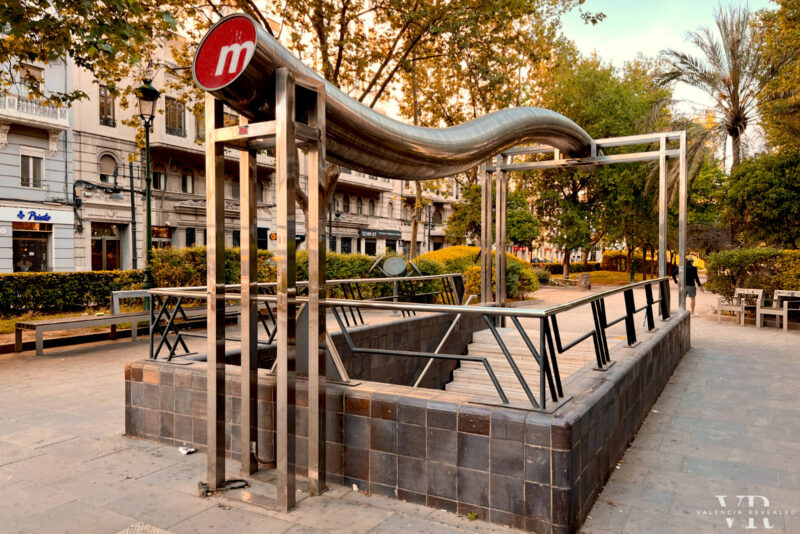
The best way to get around Valencia is by metro . The underground metro system in Valencia is inexpensive, fast, reliable, and clean. It reaches the airport and various neighborhoods but also connects Valencia with the nearby villages.
However, you cannot go everywhere by metro and sometimes you’ll have to take the bus . The bus network is more extensive and reaches all neighborhoods. You can also take a bus to go to a number of villages and commercial centers outside Valencia.
Biking is another great alternative to the underground metro, having a huge advantage in that it’s environmentally friendly. There are over 175 km of bike lanes all over Valencia and you can even go on day trips outside Valencia by bike .
Last but not least, taxis and ride-sharing services really come in handy when you have a lot of luggage or need a ride at night, outside of the metro’s operating hours.
As you can see, the best public transport method in Valencia depends on where and when you want to travel.
If you are only visiting Valencia for a few days, you’ll likely not need to use public transport more than on a handful of occasions.
Valencia is a very walkable city and depending on where you’re staying, you might be able to walk pretty much anywhere and have little need for public transport.
If you want to avoid using public transport as much as possible, I recommend staying in the Old Town. This way, most tourist attractions will be within walking distance from your accommodation.
When staying in the Old Town, you’ll only need to take public transport to go to the beach, the El Cabanyal neighborhood, the City of Arts and Sciences, and Bioparc. If you have time to spare and don’t mind a long stroll, the last two are also reachable on foot from the city center.
If you haven’t booked your accommodation yet, check out the best neighborhoods to stay in Valencia as well as the top boutique hotels in Valencia .
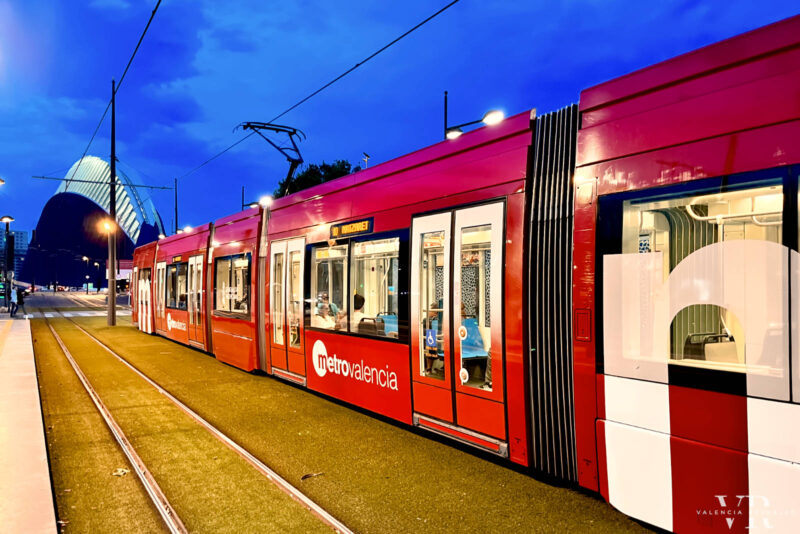
Both metros and trams in Valencia are part of the same network, called MetroValencia. There are 10 lines – 6 metro lines (lines 1, 2, 3, 5, 7, 9) and 4 tram lines (lines 4, 6, 8, 10).
Trams and metros in Valencia are a clean, fast, reliable, and inexpensive way of moving around the city. All coaches are air-conditioned.
Service frequency is 10 minutes on average but it varies greatly between individual lines and the time of the day. Usually, several metro lines share the same stops and routes in the city center, often reducing the service frequency to 5 minutes, especially during rush hour.
As a consequence, the metro in Valencia is rarely crowded to the level that it feels uncomfortable.
Benefits of using the metro in Valencia
There are a number of benefits to using a metro in Valencia.
- Kids under 10 travel for free (up to 2 kids per adult)
- You can take your e-scooter or folded bike on the metro or tram. Unfolded bikes can only be taken on board on overground segments of the MetroValencia network and on underground segments on weekends only
- Assistance dogs, as well as small animals, such as cats and small dogs, can travel on the metro in a closed carrier
- Metro and tram stops are announced well in advance, so you don’t risk missing your stop
Metro and tram zones
Valencia’s metro and tram network is divided into three zones. Zone A, B, and the airport.
Zone A covers the entirety of the city of Valencia and several nearby villages. If you are only visiting Valencia for a few days, this is the zone you are interested in.
Zone B covers a bunch of villages that are further away from the city. Metro lines reaching these villages run at a low frequency – 1 or 2 per hour.
A third zone, which appears as zone C or + on MetroValencia maps consists exclusively of the Aeroport metro stop. The metro fare to the airport is a bit higher (€4.80), however, the airport is located only 10 km from Valencia city center or 25 minutes from the city center.
Metro and tram operating hours
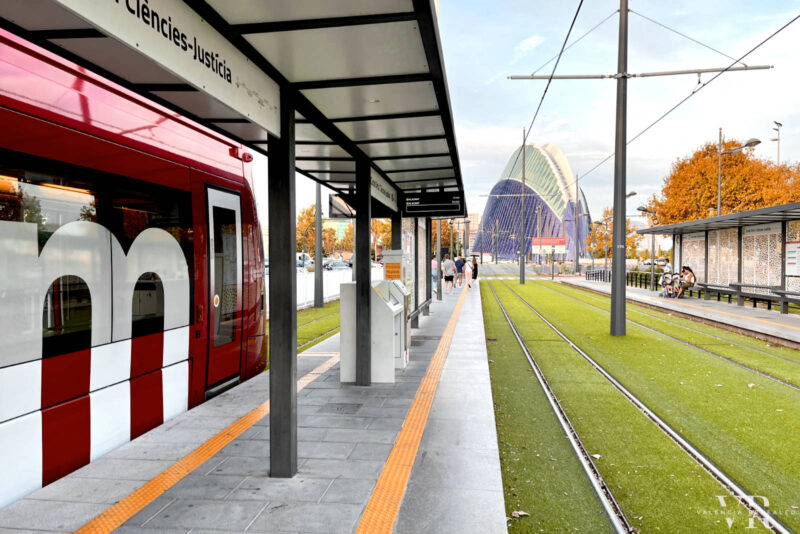
Each metro and tram line operates on a slightly different schedule. For this, it’s best to check the exact timetable for the route you’re interested in.
As a general rule of thumb, metros and trams in Valencia stop pretty early. Which is surprising for a city that goes to sleep so late.
To give you an idea, trams, and metros in Valencia start running around 6 AM .
From Sunday to Thursday, the last service is somewhere a little after 10 PM . On Fridays, Saturdays, and public holidays, however, trams and metros run until almost 3 AM, with a maximum of 3 services per line per hour after midnight.
How to buy a metro or tram ticket
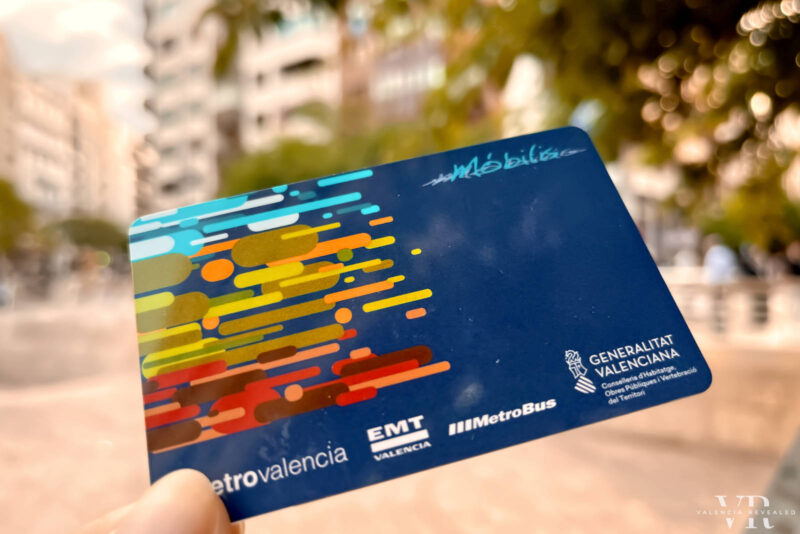
Metro and tram tickets can be bought at any metro station and on tram platforms.
You can use the vending machines to buy single tickets or Móbilis travel cards .
For single journeys, you can also pay directly with your credit card, smartwatch, or mobile phone, without the need to purchase a Móbilis card. This option is currently being implemented and might not be available in all metro stations yet.
The vending machines offer multiple language options, and you can easily switch between them by tapping on the small flags displayed on the screen.
In popular transport hubs such as Àngel Guimerà, Xàtiva, and Colón there’s always somebody to help you with your purchase.
You can pay in cash or by card .
When you purchase your first Móbilis travel card, you will be charged €1 extra for the paper card or €2 extra for the plastic, more durable card.
When the number of journeys on your card runs out, you reuse it by topping it up.
If you want to see how many journeys you have left, you can do so by simply inserting your card into the smaller card readers available in metro stations.
Types of metro tickets available
Several types of tickets and passes are available, which can be confusing. Here I’ll only highlight 3 of them, which I believe are the most useful for someone visiting or even living in Valencia , but who doesn’t use public transport on a daily basis.
Note: A temporary financial aid is currently in place until December 31st, 2023 . This means you’ll get a 50% discount on all SUMA 10 and TuiN card purchases . The prices shown in the article are the normal prices.
- Single ticket – €1.50 per journey within zone A and €4.80 for going to the airport (there are no discounts for round trip tickets)
- SUMA 10 – €0.80 per journey within zone A. This is a multi-ticket rechargeable card. The minimum top-up amount is €8. It is zone specific – once you top it up, you can only use it to travel within that particular zone. It can be used on MetroValencia, EMT, MetroBus, and RENFE Cercanías (basically, on the entirety of Valencia’s public transportation network).
- TuiN card – €0.80 per journey within zone A and €2 for going to the airport. This is a multi-ticket rechargeable card. The minimum top-up amount is €5. It can only be used on the MetroValencia network (metro and tram). The biggest advantage of this card is that it can be used in multiple zones.
Important: Both the SUMA 10 and TuiN cards can be used for groups of up to 15 people traveling together. This is important because you can purchase one card for your whole party.
How to validate your metro ticket in Valencia
Remember to always validate your ticket before getting on the metro or tram. If you fail to do this, you risk a fine. You might also have to tap your ticket on the way out.
Validating your ticket on the way in
Underground stations in the city center usually have full-panel ticket gates. To open the gates, tap your ticket or transport card on the red circle.
Most tram stops in Valencia, as well as some above-ground metro stations (often on the outskirts of the city), have free access to the platforms. Here too, you’ll have to tap your card on the red circle before getting on the metro or tram.
Tapping your ticket on the way out
On your way out you’ll also have to tap your ticket. But there are some exceptions.
When using the metro, you always have to tap your ticket on your way out, whether there’s a turnstile gate or not, to avoid being overcharged.
When using the tram, however, if there’s no turnstile gate, you don’t need to validate your travel card when you get off, since all tram stops are in zone A. But, if there is a turnstile gate, you’ll have to validate your ticket for the gates to open.
Tip: If you have several travel cards, remember to use the same one to validate both on your way in and on your way out.
Good to know when using the metro in Valencia
Here are some practical tips for using the metro in Valencia.
- The maximum travel time per journey is 90 minutes from the moment you validate your ticket (within one travel zone). During this time, you can transfer between tram and metro lines as needed
- You can only travel in the zone your title is valid for
- Metro lines 3 and 5 connect the airport to the city center
- Metro line 5 also connects the airport to the seaside neighborhoods. If your accommodation is close to the beach, change to tram line 6 or 8 at Marítim. You’ll have to tap your ticket again at Marítim – you won’t be charged extra
- Get off at either Àngel Guimerà, Xàtiva, Colón, or Alameda station for the city center
- No metro line goes all the way to the beach. For Playa del Cabanyal, take tram lines 4, 6, or 8. For Playa de la Malvarrosa, take tram lines 4 or 6.
- To go to the City of Arts and Sciences, take tram line 10 from the city center
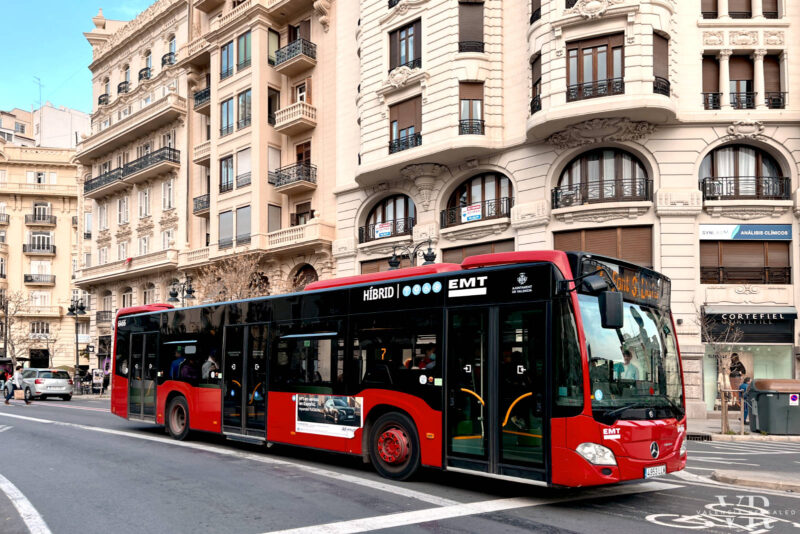
Valencia has an extensive bus network that reaches all neighborhoods. Buses in Valencia are clean, comfortable, safe, and a great way to travel if you want to enjoy the cityscape . All buses in Valencia have air conditioning.
Valencia is served by two types of buses – EMT city buses (red) and MetroBus buses (yellow) . The latter connects Valencia with the nearby villages and commercial centers on the outskirts of the city.
Using the bus in Valencia is a great option if you want to reach a part of the city that doesn’t have a metro or tram stop nearby.
But using the bus comes with a few limitations to take into consideration.
- Bus journeys typically take longer than metro rides
- The duration of bus trips is dependent on traffic conditions
- Buses usually tend to be more crowded compared to the metro, particularly during peak hours
Below I’ll be talking about EMT city buses only.
EMT has a fleet of nearly 500 buses. Many of them are hybrid electric.
There are 45 bus lines operating in the city during the day. The frequency of the service varies between individual lines.
During peak times many lines have a frequency of approximately 10 minutes . But they tend to be less frequent very early in the morning and late at night, as well as during weekends and on public holidays.
During the night , there are approximately a dozen bus lines operating in Valencia. These buses are called CorreNIT and they run at a frequency of approximately 1 to 2 hours.
How to pay for the bus in Valencia
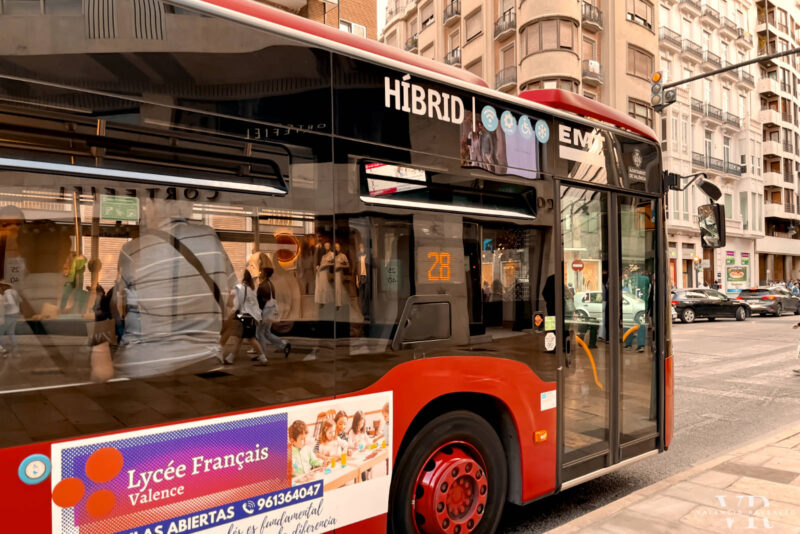
Tickets can be purchased directly on the bus, as well as from EMT offices, kiosks, and tobacco shops around the city.
For single journeys, you can pay in cash to the driver (having exact change is recommended). You can also pay with your credit card, smartwatch, or mobile phone .
If you have a Móbilis card , tap it on the red circle as soon as you get on the bus.
Types of bus tickets available
EMT offers several types of bus tickets and passes. Out of all the options, I will only emphasize 3 that I believe can be the most beneficial for visitors and infrequent users of Valencia’s public transportation system.
Note: A temporary financial aid is currently in place until December 31st, 2023 . This means you’ll get a 50% discount on all SUMA 10 card purchases . The prices shown in the article are the normal prices.
- Single ticket – €1.50 per journey (there are no discounts for round-trip tickets)
- SUMA 10 – €0.80 per journey. This is a multi-ticket rechargeable card. The minimum top-up amount is €8. It can be used on EMT, MetroBus, MetroValencia, and RENFE Cercanías (basically, on Valencia’s whole public transportation network). Zone specific.
- EMT Mascota – a personalized card for pets under 15 kg traveling in a carrier. It costs €5 and is valid for an unlimited number of journeys. It has to be renewed every 2 years.
Good to know when using the bus in Valencia
Here are a few things you should know when using the bus in Valencia.
- You have to put your hand out to signal the bus driver to stop. This is particularly important if a bus stop is used by several bus lines
- Use the front door to board the bus. Use the rear door to exit
- Pay or validate your travel card as soon as you get on the bus by tapping the red circle next to the driver
- Press the “Stop” button in advance to let the driver know you want to get off at the next stop
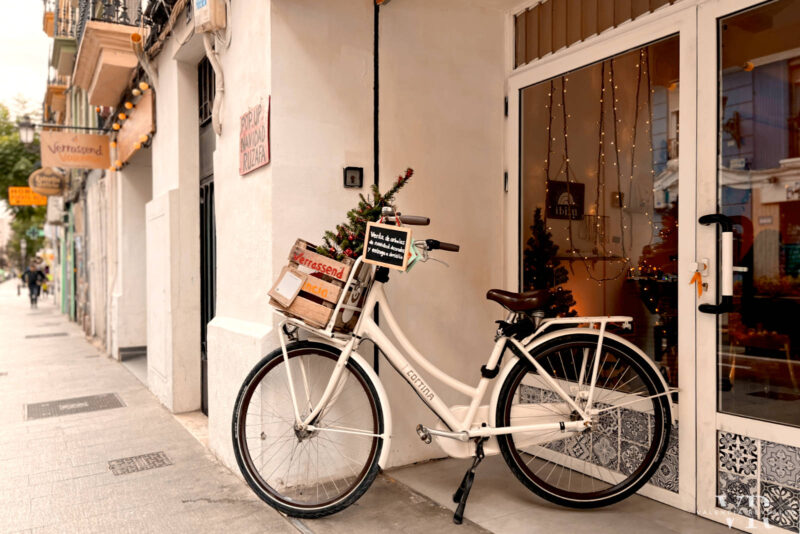
Biking is another great mode of transportation in Valencia and it comes with a lot of freedom and flexibility to explore.
As one of the most bike-friendly cities in Spain, Valencia has over 175 km of bike lanes reaching all neighborhoods and even some of the nearby villages.
On top of that, the city is pancake flat and has a 9 km long green lung that crosses the city from east to west. This is known as Turia Park , a former riverbed converted into a lush public garden.
The weather in Valencia is pleasant year-round. Even winter in Valencia sees day temperatures within double digits Celsius. This means no freezing cold hands while riding your bike during the cold months, which in Valencia are basically January and February only.
If you need even more reasons to hop on a bike, then the fact that it’s a healthy, cheap, and environmentally-friendly way to get around should seal the deal.
If your preferred mode of transportation is biking, then in Valencia you basically have 3 options.
Bike sharing
The bike-sharing scheme in Valencia is called Valenbisi . They have a fleet of approximately 2,750 bikes and over 275 docking stations throughout the city.
Not only are they accessible, but they are also cheap – €13.30 per week or €29.21 per year.
This is the cost of the basic subscription and it comes with 30 free minutes for every ride . If you use the bike for trips exceeding 30 minutes, additional charges will apply for every hour that passes.
Valenbisi is a great option to get around Valencia on the cheap. But it’s not a good option if you want to explore the city stress-free and without looking at your watch every 5 minutes.
Also, if you want to go on a day trip to Albufera or visit the tigernut fields in Alboraya, it can get pretty expensive.
Another caveat is that Valenbisi bikes are heavy and they only come in one size . If you are in Valencia with kids , you might want to look into other options.
Bike subscription
If you plan on staying in Valencia for more than a month, a bike subscription might be just what you’re looking for.
Kleta is a bike rental company located in Ruzafa. They have both bikes and e-bikes and their subscription starts from €19.90 per month and €44.90 per month respectively.
This includes unlimited repairs and an anti-theft guarantee for peace of mind. You can also customize your bike with a basket or child seat.
Bike rental and tours
If you’re in Valencia for a few days only, you can either rent a bike per day or join a guided bike tour.
Bike rentals in Valencia usually start from €10 per day and you can choose from a variety of bike sizes.
Most guided bike tours start in the city center . Some of them will take you to the beach, others to the City of Arts and Sciences, or show you around the historic center.
Also read: Top Biking Routes in Valencia (+ Other Useful Tips)
Because Valencia is such a compact city, taxis and similar ride-hailing services are not top of mind when thinking about public transport. But they do come in handy if you are traveling late at night or have a lot of luggage.
Hailing a taxi
To hail a taxi, you can either call by phone, use the FREE NOW app, take a taxi from a taxi rank, or put your hand out when you see a taxi with a green light – this means the taxi is available.
All taxis in Valencia run on a meter . Night rates are higher than day rates. A minimum trip cost applies – €4.30 during the day and €6.40 during the night.
Cabify and Uber Taxi
Cabify and Uber Taxi operate in Valencia. Both companies have clearly branded cars. Ordering a ride is through their respective apps.
Disclaimer: Please note that the information provided in this article is solely intended for informational purposes. Rates, schedules, and conditions related to public transport are subject to change without prior notice. While I strive to ensure the accuracy of the information contained in this article, I highly recommend that you verify the details with the relevant service providers before your trip.

Hola Lara, That was a really informative detailed article on Valencia transport system. Thank you so much for sharing this article. I wanted to ask you how is the train system in Valencia? Can we ride trains from Valencia to reach other Spanish cities for example: Barcelona, Madrid, Seville, Granada, Cordoba or Malaga?
I am looking forward to hear from you soon.
Yes, you can take a train from Valencia to several major Spanish cities, but in some cases, flying can be faster/cheaper. That being said, the best way to reach Madrid is by fast speed train. All the other cities you’ve mentioned are 3+ hours away by train. Spanish trains are comfortable and clean and I highly recommend them.
Leave a Comment Cancel reply
Comments are publicly visible. Kindly refrain from sharing any personal or private information.
Tourist Information Guide
Valencia metro map: map of the underground system in valencia, spain, page content.
Valencia's metro system has six lines and covers most of the city. It is worth having a look at the metro map prior to your visit and checking out the closest metro to your accommodation. You can then check how to get to the various attractions that you would like to visit on the metro from where you are staying.
This page will provide you with the official Valencia metro map.
Transfers to / from Valencia Airport
Metro Map for Valencia Metro System

For a guide to the Valencia metro - ticket options, ticket prices, timetable and how to buy tickets, see our Guide to Valencia Metro .
Using the metro is a convenient and quick way to get around Valencia. For your other public transport options, see our Guide to Transport in Valencia city centre .
Back To The Top Of The Page
How to Take the Metro in Valencia
Learn exactly how to use the metro in Valencia. This form of transport is simple, clean, safe, and pretty affordable. Even though it’s not as expansive as in other cities, it’s still a convenient way to get around – especially during the hot summer months! Let’s take a deeper look at everything you need to know.

Leave at the Turnstile
Notes about trams, monthy and tuin bundles, valencia metro guide.
The underground metro system in Valencia is a really intuitive form of transport. Even if you’ve never taken the subway before, you won’t have any problems using the metro in Valencia.
In this guide, I’ll tell you the exact steps you need to take, what your payment options are, and some top tips to make your trip easier.
And if you want support on other forms of public transport, make sure to check out the full Valencia transport guide!

There are a few different options that you should consider when jumping on the metro. But first, let’s stick to the easy part .
Here are step-by-step instructions to use the metro in Valencia:
Get Your Ticket

Before you’re able to get on, you need to have a valid ticket . At any of the metro stations, you’ll come across a red and white machine towards the entrance. This is where you can purchase your ticket.
You can always pay with your credit card, and most of the time you can pay with cash if you prefer.
At the machine, you’ll first be prompted to either “ Purchase ” or “ Recharge ”.
Choose “purchase” ( comprar ) if you need to buy a new card/ticket OR if you want to change the type of ticket (more on that below). Choose “recharge” ( recarregar ) if you want to quickly purchase the same type of ticket that you previously owned.
Afterwards, it will ask you if you have a physical card that can be recharged. Because your “ticket” is digital – but you need a physical card that is loaded with this ticket .
- If you have one – simply select “Yes” and place it on the circular scanner.
- If you don’t have one – you’ll pay €1 for paper card
The cardboard-ish paper card is also rechargeable – so make sure to save it!
We’ll jump a little deeper into specific ticket options further down the article.
Note : If you have any trouble, most of the metro stations will also have attendants who can help.
Scan Your Ticket
After you have a card that has an active ticket on it – just walk through the turnstile.
You walk up, scan your card, and then walk through.
It’s really that simple. Just don’t lose your card, as you’ll have to scan on the way out, too.
Take the Right Metro

As you walk in, look for signs to the line you need to take. You should use the Metro Valencia official site to plan which line you need to take.
All the metro lines are color-coded and numbered . For example, Line 3 is the only red line on the map.
This makes it really user-friendly and easy to figure out. The only thing you need to worry about is making sure you walk towards the right direction.
Here’s an example :
Line 3 goes towards either the Aeroport (Airport) or Rafelbunyol (a nearby town). If you are inside the Xàtiva station, and you want to go to Benimaclet – then you’ll get onto Line 3 via the platform that specifies Rafelbunyol .
You should see the name of the specific direction (Aeroport or Rafelbunyol) on:
- The electronic timetable panels
- The panel on the front of the incoming metro
Just pay attention to get off at the Benimaclet station (in this example). You’ll hear an announcement in Valencian, and you’ll also see the name of the current station light up on the panel above the door.
Likewise, to get back to Xàtiva later on, you’ll jump on Line 3 towards Aeroport.
This type of example holds true for basically any trip!
After you get off the metro – you’re free to take a different one if needed. Most of the time this isn’t necessary, but if you do need to make a transfer, you don’t need to pay for a second trip.
To leave, all you need to do is scan your card once again at the turnstile. This is the check to make sure you’ve purchased the correct type of ticket.
So if you want to avoid any fines – make sure to keep reading to learn which type of ticket you need to buy.
Valencia Metro Map
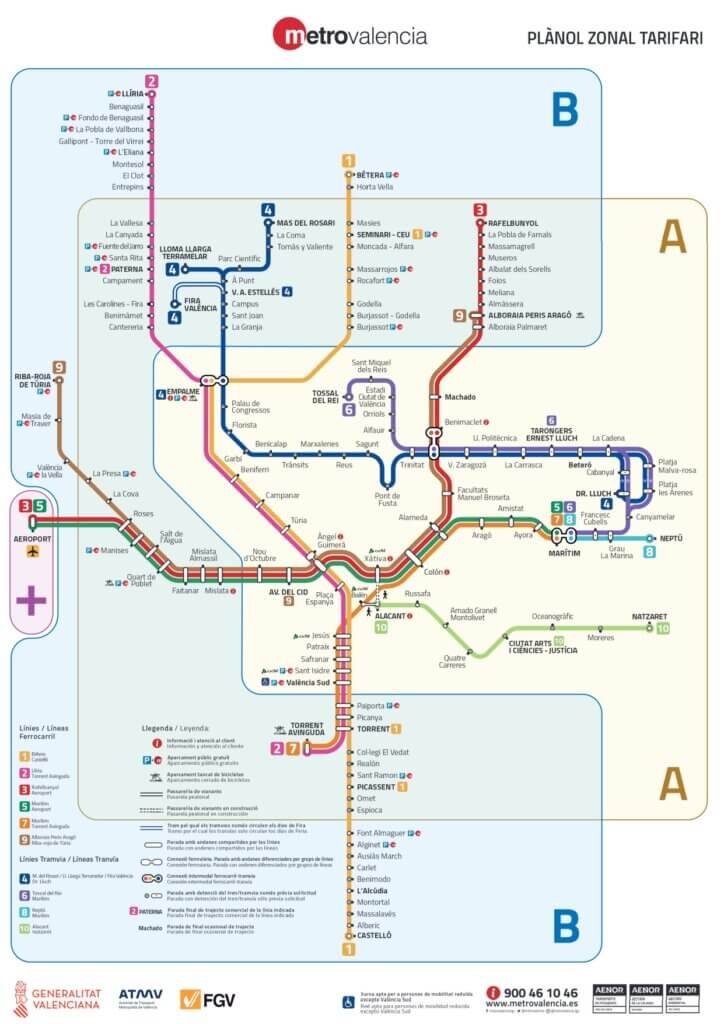
Here’s a map of the entire Valencia metro system . Let’s go over how to read the map, so you can plan your trip better.
The Metro Zones are broken up into 3 different sections: “ A ”, “ B ”, and “ + ”.
The “ + ” only refers to the airport . So if you need to go to/from the airport, you have to have an AB+ ticket.
Then for the majority of tourists, you’ll only need to be traveling within Zone A . That’s because Zone B is almost exclusively for small nearby towns.
You’ll see that a few lines do overlap and follow a relatively similar path, especially in the city center. This can help make your trip a bit faster, as you’ll have more options.
I find these are the most important lines to know as a tourist :
- Line 3: Connects the airport, the city center, and Benimaclet
- Line 5 : Connects the airport, the city center, and the beach.
- Line 7 : Connects the city center and the beach
- Line 10 : Connects Russafa and the City of Arts and Sciences
Of course these are not the only lines – but they are the ones you should know as a tourist.
- From a practical sense – the trams function as an extension of the metro . In other words – your metro tickets work on the tram.
- The outdoor, surface-level entrance onto the tram doesn’t usually have a turnstile. Instead, you’ll have a ticket validation machine you need to scan .
- Most tram stops don’t have a machine to purchase new tickets . So make sure you plan for that ahead of time if you need to take a tram.
- You don’t pay extra for transferring to a tram after using a metro. For example, you only pay for 1 trip if you take Line 5 from Xàtiva to Marítim, then take the tram 8 to Neptú (although you do need to scan your card to enter).
Valencia Metro Ticket Prices
Now let’s talk about the most confusing part on how to take the metro in Valencia.
The ticket prices.
Because the system has undergone a couple changes within the last decade . In fact, most of the resources I found in English are completely outdated.
Note : Make sure to check the official page for any updates.
So let me explain the new system, as of 2024 .
As a general statement, you have 5 different categories of tickets:
- Single tickets
- SUMA 10 bundles
- SUMA T bundles
- Monthly bundles
- TuiN tickets
I’ll dig a bit deeper into each one. But for a quick summary:
- SUMA 10 tend to be the best overall option
- Single tickets are great if you won’t use much public transport
- SUMA T is included within the Valencia Tourist Card
- Monthly and TuiN tickets are only convenient for residents
Single Tickets
This is a convenient option for people who won’t need the public transport too much. In fact, buying a single ticket to/from the airport is much cheaper than getting a taxi , so that can be a great option.
Here are the prices for single ( Senzill in Valencian) tickets:
Those prices do not include the cost of the metro card . You can purchase the €1 paper card at the same machine when buying your ticket.
The fares work in reverse, as well. So if you go from the airport ( + ) to the city center ( Zone A ), it will cost €4.80 , plus the €1 if you don’t have one.
Important to note : you can load multiple single tickets onto the same card. This means if you’re traveling with multiple people, only one of you needs to purchase the paper card. You’ll just scan the same card multiple times at the turnstile.
SUMA 10 Tickets
SUMA is a really convenient option because it is an integrated ticket . This means it is valid for the metro, tram, bus, and local train.
The SUMA 10 is a bundle of ten single trips . For 90% of visitors, you’ll choose the “ A, B, C, or D ” ticket type for €8 .
Although there are different options for people that will need to travel in between multiple zones more frequently.
I highly recommend the SUMA 10 for most people because it’s a more cost-effective way to travel, and it’s not very difficult to rack up 10 trips. Especially because you can use the same card for multiple people.
It also doesn’t expire, so if you’re staying for a longer period of time – there’s no pressure to use up your metro trips. The only downside is that the €8 ticket does not include the airport .
From January 1st until July 31st of 2024 – all the SUMA 10 tickets have a 50% discount.
Note : A single trip is counted when you scan in and out. So if you take a metro, then take a bus – that counts as 2 trips . The only exception is for metro-tram connections.
This type of ticket allows you to have an unlimited number of trips on the metro, tram, bus, or local train for a specific amount of time.
Here are the prices:
These can be a convenient option if you know you’re going to be using the public transport a lot.
However, I usually only recommend this type of ticket for people getting the Valencia Tourist Card . This is a discount card that has these transport options included, as well as provides free access to municipal museums.
But if you don’t want to tourist card, there are 3 reasons why I don’t usually recommend this for travelers:
- You’re restricted to 1 person per card
- Most people won’t use the metro more than twice a day
- It’s time -sensitive
The timer starts from the second you activate your card on your first trip . In other words, if you go from the airport on Friday at 2pm, the 48-hour ticket will expire at 1:59 pm on Sunday.
Of course, it really depends on your specific travel group and style . For some people, it can be cheaper! Feel free to do the math and figure out which works out best for your trip.
And remember – feel free to send me a message if you have any questions!
The Monthly SUMA and TuiN options are great for people living long-term in Valencia.
With the monthly SUMA bundles , you pay €35 for unlimited access for single zones within the city. The price increases as you expand out.
These bundles are ideal for people who might want to live in another city, but frequently travel to Valencia. Plus, there are discounts for people who are younger than 31.
Not to mention that residents under 31 who register are currently getting completely free public transport (as of Jan. 2024).
The TuiN Card is a different approach altogether . This is a personalized card that allows you to charge a specific amount of money onto it. Then, you can take different types of trips for a discounted price.
This is convenient as you never need to worry about changing the type ticket , you just get charged as you go. Plus, it’s much cheaper per-trip. For example, the AB+ (to the airport) is only €2.
The downside : you need to make an appointment to pick up the card. And you can’t pick it up at the airport desks. Which makes it really inconvenient for tourists .
But if you’re staying here for a long time – it’s a great option!
Valencia Metro Hours

The metro in Valencia is not a 24-hour service . While they sometimes have night-time service, as of January 2024 – it’s not a common occurrence.
During the week, it’s open from 04:00 to 23:30pm .
On the weekend, it’s open from 05:00 to midnight .
If you need to leave earlier or you want to use public transport after some nightlife, you’ll need to either use the bus or taxis .
Tips on Using the Metro in Valencia
Overall, it’s quite easy to use the metro in Valencia. There isn’t too many tricks to it – especially once you understand how the tickets work.
But here are a few tips to help make your trip go even smoother:
- Plan your route via the Metro Valencia app – not Google Maps
- Remember it can get fairly crowded
- Give yourself enough time to buy the tickets
Valencia Tourist Card
The Tourist Card is a discount card that has the SUMA T titles loaded onto them.
These are super convenient for tourists who are only spending around 3 days in Valencia. You get free access to municipal museums , plus discounted access to the emblematic City of Arts and Sciences.
So it’s a great way to visit all the major monuments for a cheaper rate – plus it has the SUMA T+ transport tickets already loaded onto it!
If you’re planning on visiting the most important attractions and you’d like to take advantage of public transport – this is the way to go!
I hope this guide has helped you understand exactly how to take the metro in Valencia! If you still have any questions or concerns, just reach out . I’m always happy to help.
Check out these other resources to learn more about the Valencia public transport system:
- Full Guide to Public Transport
- How to Rent a Car
- The Best Way to find Cheap Flights
- How to Take the Bus
- How to Get to the City Center from the Airport
- How to Take a Train in Valencia
Yes, Valencia boasts an efficient metro system that connects all major parts of the cities.
As of the time of writing, masks are not mandatory on the metro. However, it’s now common courtesy to wear them if you’re feeling sick.
For the majority of tickets – yes. However, for people on the SUMA T or Valencia Tourist Card, then no.
Need help planning your trip to Valencia?
Here are the tools I use for the cheapest (and most reliable) vacation planning:
- 🏠 Booking – Affordable hotels and apartments
- 🏠 Hostel World – Safe and budget-friendly hostels
- ✈️ Skyscanner – My favorite tool for cheap flights
- 🚗 Discover Cars – Best place for car rentals
- 🚄 Trainline – The easiest way to book local trains in advance
- 📶 Airalo – eSim cards for easy internet access while traveling
- 🦺 Safety Wing – The #1 travel medical insurance
- 💸 Airhelp – Cancelled flight compensation (it’s free!)
- 💱 Wise – Easiest low-fee way to transfer currency
Affiliate disclosure: This post may contain affiliate links. These are links to services I personally recommend using for your trip to Valencia. At no extra cost to you , I may earn a small commission from these brands if you choose to make a purchase. Your support helps me pay my bills and eat more bunyols!
For your trip

Is Valencia Worth Visiting? Here’s Everything You Need to Know

The Top 50 Things to Do in Valencia (Spain, April 2024)

Valencia: Tips and Tricks to Travel Like a Local
Get a free itinerary.
Get the whole weekend planned out for you ( by someone who actually lives here ).
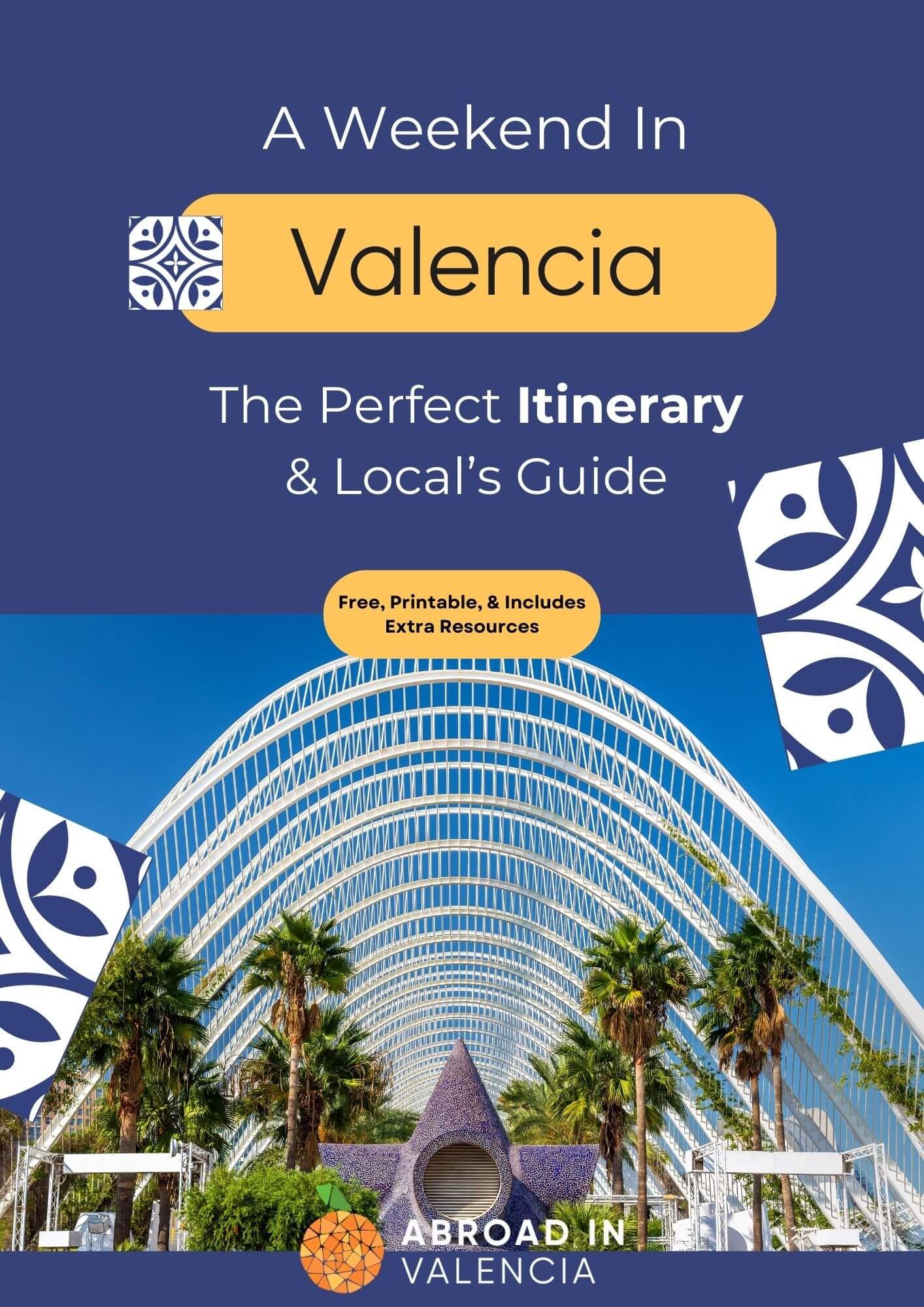

Valencia Public Transport: The Ultimate Guide (By a Local!)
Navigating a new city can be overwhelming, especially when it comes to public transportation.
So if you’re planning a trip to Valencia, Spain, you may find yourself wondering how to get around efficiently and affordably. Luckily, the city has a robust public transport system that can make exploring a breeze.
But with so many options available, how do you know which mode of transport to choose? Whether you’re a budget-conscious traveler or simply looking for a hassle-free way to see the sights, this article will provide all the information you need to make the most of Valencia’s public transport system.
From buses to metros to trams, I’ll break down the pros and cons of each method, offer insider tips for using public transport like a local (I do live here, after all – and I don’t have a car, so bikes and public transport here in Valencia are my daily life!) , and highlight the best routes for popular attractions.
Table of Contents
What Options for Public Transportation in Valencia Are There?
If you’re planning a visit to Valencia, you’ll be happy to know that the city has an excellent public transportation system. Whether you’re traveling for business or pleasure, you can easily get around the city without the need for a car.
Valencia’s public transportation system includes buses, metro, and tram, which will take you to all the major tourist attractions and neighborhoods.
Valencia’s bus network is extensive, with over 60 lines that cover the entire city. Buses run from early morning until late at night, and you can purchase tickets from the driver or at a metro station.
The buses are clean, safe, and air-conditioned, making them a comfortable option for getting around the city.
And if you plan on using the bus frequently during your stay, you really should look into getting a Valencia tourist card – offers free, unlimited travel for the period you buy it for!
Planning a trip to Spain? See if you can ace our free quiz to check how much you really know!
The Valencia metro system is modern and efficient, with nine lines that cover the entire city. The trains run from early morning until late at night, and they are air-conditioned and comfortable.
The metro is an excellent option for getting around the city quickly, and it’s easy to navigate. You can purchase tickets at the station or use a transport pass that offers unlimited travel for a set period.
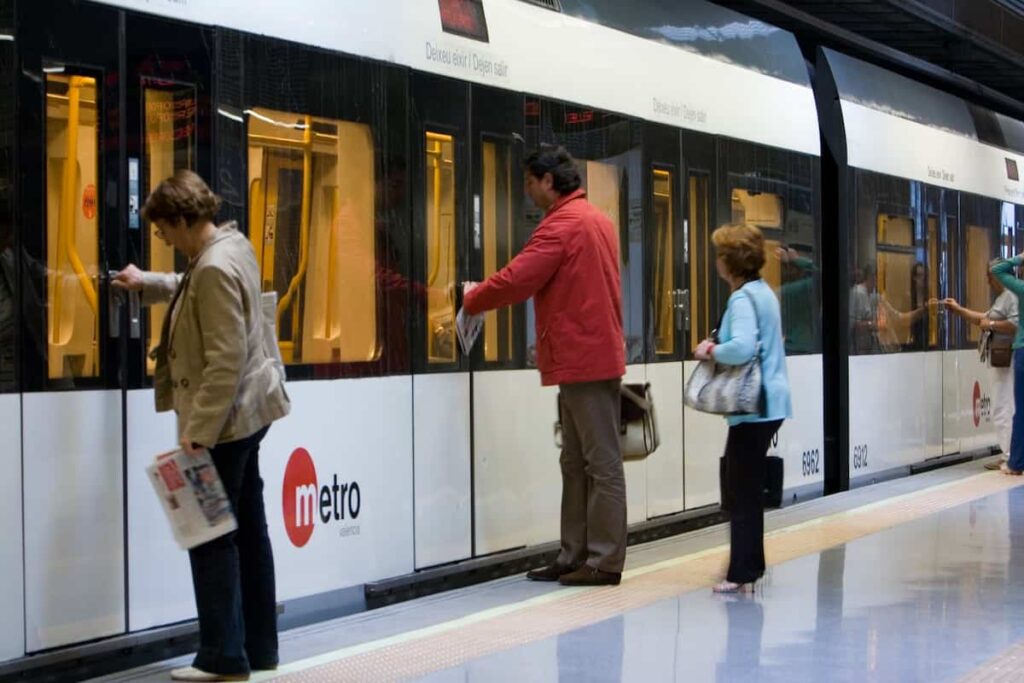
The Valencia tram system is a great way to explore the city’s coastal areas. The tram runs along the coast and connects the city center with the beach.
Each tram is air-conditioned and comfortable, and it’s a great way to enjoy the beautiful views of the Mediterranean Sea. You can purchase tickets at the station or use a transport pass that offers unlimited travel for a set period.
Tickets and Passes
Getting around Valencia is easy and affordable with the city’s public transportation system. Whether you’re a tourist or a local, there are several ticket options available to suit your needs. Here are some of the most popular:
Valencia Tourist Card
If you’re a tourist planning to explore Valencia, the Valencia Tourist Card is a great option. It offers unlimited travel on buses, metro, and trams within Zone A, as well as discounts on entry tickets to many of Valencia’s main attractions.
The card is available for 24, 48, or 72 hours, and prices start at €15. You can purchase the card online or at tourist information offices throughout the city.
Single Ticket
If you only need to take a few trips on public transportation, a single ticket is the way to go. You can buy a single ticket for €1.50 when boarding the bus or at ticket machines located in metro stations.
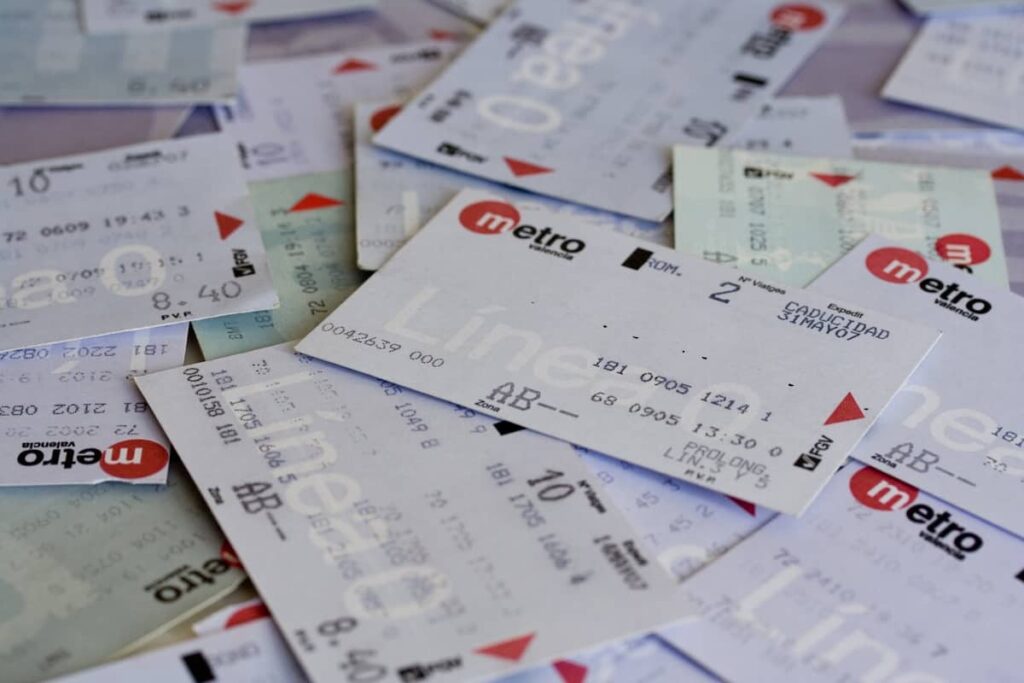
Transport Passes
If you plan on using public transportation frequently during your stay in Valencia, a transport pass may be a more cost-effective option.
For example, the Mobilis Card offers unlimited trips on buses, metro, and trams within Zone A (which is the city center and the beach, so probably as far as most tourists will go) for 24 hours, and costs €7.20. Another option is the Bonometro Card, which offers unlimited trips on the metro and tram within Zone A for 10 days, and costs €8.70.
On the other hand, the Bonobus Card offers 10 trips on urban and intercity buses, and costs €9.70.
All of these cards can be purchased at ticket machines located in metro stations and at tobacco shops throughout the city.
The Valencian government offers discounts on multi-journey transport passes. The discounts bring the price of a SUMA 10 pass (valid for metro, tram, buses, and railways) down to €5.60 (one zone), €8.40 (two zones), and €14.00 (three zones).
Keep in mind though that these discounts are subject to change, so be sure to check the latest prices before purchasing your tickets.
Does Valencia have good public transportation?
Yes, Valencia has an excellent public transportation system that is both affordable and efficient. Whether you’re traveling for business or pleasure, you’ll find that getting around Valencia is easy and stress-free thanks to the city’s extensive network of buses, trams, and metro lines.
One of the best things about Valencia’s public transportation system is that it’s very easy to use. The city has a number of different ticket options, including single tickets, 10-journey tickets, and multi-day passes.
You can buy tickets at any metro station, tram stop, or bus station, making it easy to get started with your journey right away.
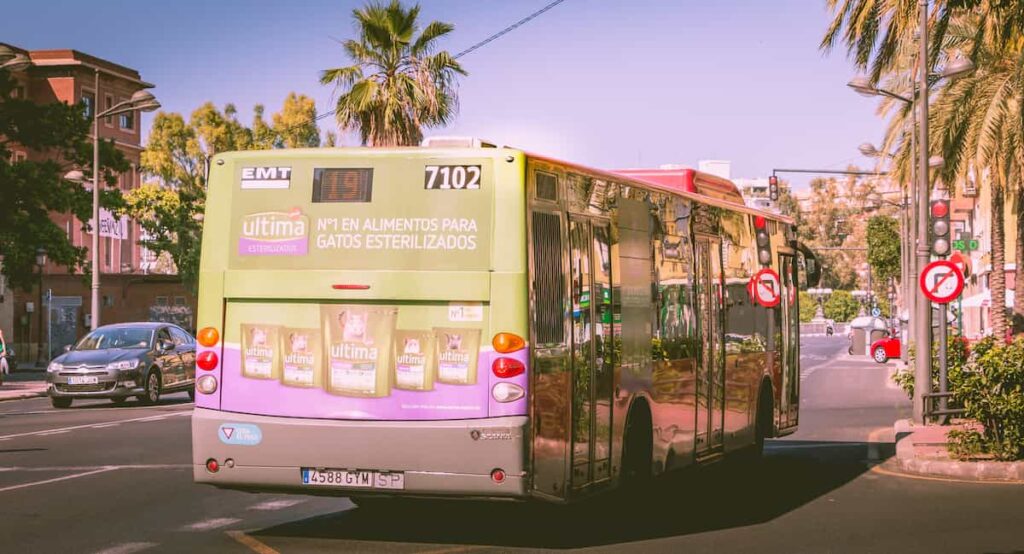
Plus, the city’s buses, trams, and metro lines are all interconnected, so you can easily transfer between them without having to worry about buying a new ticket.
Another great thing about Valencia’s public transportation system is that it’s very affordable. Single tickets start at just €1.50, and multi-day passes are available for as little as €7 per day. Plus, if you’re traveling with a group, you can take advantage of the city’s group discounts, which can save you even more money.
So whether you’re traveling on a budget or just looking to save a little extra cash, Valencia’s public transportation system is a great option.
How to Buy Public Transport Tickets in Valencia
Valencia has a reliable and efficient public transportation system that can take you anywhere you need to go in the city. Here’s a quick guide on how to buy public transport tickets in Valencia.
The easiest way to purchase tickets is at one of the many kiosks or estancos scattered throughout the city. You can also purchase tickets online or through the EMTicket app.
The Valencia Tourist Card is another option that includes free unlimited transport on the metro underground, buses in Valencia city center, and discounts on entry tickets to many of Valencia’s main attractions.
If you plan on using public transportation frequently during your stay, the SUMA card is a great option. It allows you to take 10 trips on urban and intercity buses, metro, tram, and suburban trains for just €10 (€8 + €2 for the card).
Take note though that both the SUMA card and Valencia Tourist Card have to be activated when boarding the bus, so don’t forget to check on.
Does Valencia, Spain have a subway system?
Yes, Valencia has an extensive subway system, which is known as the Metrovalencia. It covers a large part of the city and is a convenient way to get around. The Metrovalencia has nine lines, which cover a distance of more than 150 kilometers.
The lines run from the city center to the suburbs and beyond. The trains are modern and air-conditioned, making them a comfortable way to travel, even in the summer months.
The subway system is integrated with the bus and tram networks, so you can use the same ticket for all three modes of transport. This makes it easy to switch between the different modes of transport and get to your destination quickly and efficiently.
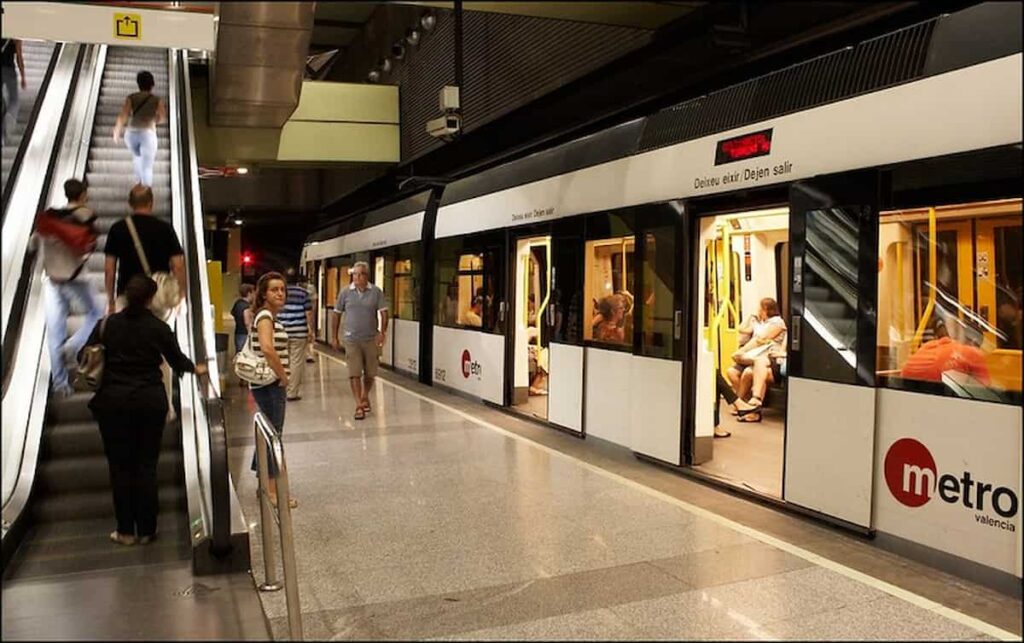
Is the Metro in Valencia Free?
No, the metro system in Valencia isn’t usually free, but it is affordable and efficient, making it a great option for getting around the city. However, on some Sundays all public transportation in Valencia is free, so check if that applies during your stay.
It’s also free if you buy a Valencia Tourist Card. This card offers free unlimited travel on the metro, bus, and tram systems in Valencia, as well as discounts on entry tickets to many of Valencia’s main attractions.
It is important to note that the Valencia Tourist Card is not free, but it can save you money in the long run if you plan on using public transportation frequently during your stay in the city.
Additionally, children under the age of 10 can travel for free on the metro as long as they are accompanied by an adult.
Can You Pay Cash on Valencia Buses?
Yes, you can pay with cash on Valencia buses. However, bus drivers may not accept large bills, so try to either pay in coins or with a €5 bill at the most. Also note that it’s often cheaper to buy a card for public transport, especially if you plan to use it a few times during your stay.
It’s for this reason that paying with cash also isn’t the most convenient option compared to purchasing a transportation pass. These passes allow you to ride the bus, metro, and tram as much as you want within a certain period of time, and they can be a more cost-effective option than paying for each journey separately.
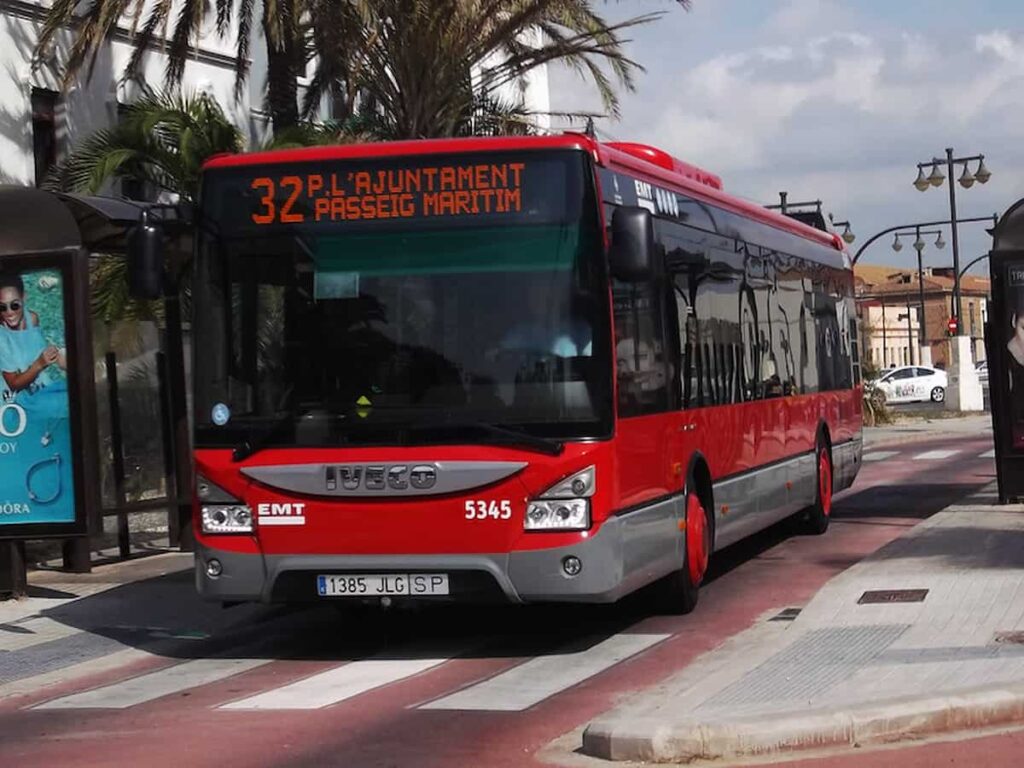
Can You Get Around Valencia Without a Car?
Yes, you absolutely can get around Valencia without a car! In fact, the city has an excellent public transportation system that is easy to navigate and affordable. Whether you’re a tourist or a resident, you’ll find that the public transportation options in Valencia are a great way to get around.
In fact, as I mentioned earlier, I live in Valencia and don’t have a car. Honestly, for me, it’s one of the best parts of living here as I can get around just as easily with public transport or (my preferred option) a bike from the city’s public bike system.
It also means that I don’t need to worry about paying for maintenance or parking. Overall, it’s a definite win-win!
And what does this mean for you if you’re just visiting? Well, you really don’t need to hire a car here. Unless you plan on taking a day trip from Valencia (although many of them can be done by train too), I would truly suggest that you just stick to public transport – or even just walking!
Anna is the founder of Spain Inspired, where she shares insider tips and hidden gems to inspire thousands of visitors each month to take the road less traveled and explore Spain like a local. Having lived in Spain for some time now, Anna's made it her mission to help fellow travelers experience the very best of this stunning country - with some great wine and tapas along the way, ideally!
Leave a Reply Cancel reply
Your email address will not be published. Required fields are marked *
Save my name, email, and website in this browser for the next time I comment.
Metro guide

- Horta Vella
- Seminari-CEU
- Moncada-Alfara
- Massarrojos
- Burjassot-Godella
- Àngel Guimerà
- Plaça Espanya
- Sant Isidre
- València Sud
- Col·legi El Vedat
- Font Almaguer
- Ausiàs March
- Benaguasil 2n
- Benaguasil 1r
- La Pobla de Vallbona
- Torre del Virrei
- Fuente del Jarro
- Les Carolines-Fira
- Torrent Avinguda
- Rafelbunyol
- La Pobla de Farnals
- Massamagrell
- Albalat dels Sorells
- Alboraya-Peris Aragó
- Alboraya-Palmaret
- Avinguda del Cid
- Nou d'Octubre
- Mislata-Almassil
- Quart de Poblet
- Salt de l'Aigua
- Vicent Andrés Estellés
- Palau de Congressos
- Pont de Fusta
- Primat Reig
- Vicent Zaragozà
- Universitat Politècnica
- La Carrasca
- Eugenia Viñes
- Doctor Lluch
- Fira València
- Ll. Llarga Terramelar
- Mas del Rosari
- Tomás y Valiente
- Santa Gemma
- Marítim-Serrería
- Amistat- Casa de Salud
- Tossal del Rei
- Sant Miquel dels Reis
- Estadi del Llevant
- Mediterrani
- Grau- Canyamelar
- Francesc Cubells
- Amistat-Casa de Salud
- Marina Reial Joan Carles I
- Grau-Canyamelar
- València la Vella
- Masia de Traver
- Riba-roja de Túria
- Amado Granell Montolivet
- Quatre Carreres
- Ciutat Arts i Ciències-Justícia
- Oceanogràfic
- Línea 4/1/1
- Línea 4/1/2
- Línea 4/2/1
- Línea 4/2/2
Metro guide around the city
Copyright © 2024 Discover Ukraine LLC.
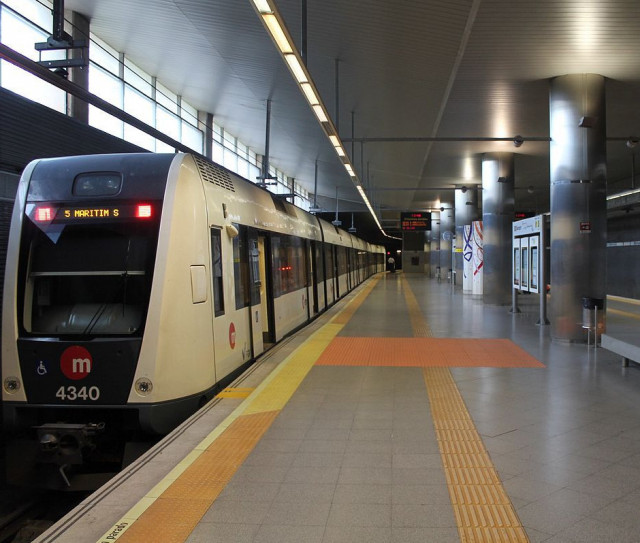
The Valencia Metro, inaugurated in 1988, ranks as Spain's third-largest and busiest metro system. It emerged from the foundation of the old Trenet de Valencia commuter rail network, which dates back to 1888. Initially, the Valencia metro encompassed 48 stations serving two key routes. One route connected central Valencia with the southern suburb of Villanueva de Castellon, while the other extended to the small town of Liria in the north. Presently, the Valencia metro network comprises six metro lines and four tram lines, with a predominant surface presence. Renowned for its convenience, speed, and cost-effectiveness, the Valencia Metro serves around 200,000 passengers daily. Its extensive coverage not only encompasses the city center but also stretches into neighboring cities and suburbs. The Valencia Metro facilitates travel to prominent transportation hubs, including Valencia's primary train station (Estacio Nord), the central bus station (Estacion De Autobuses de Valencia), the cruise port (The Port of Palma's Poniente Quay), and Valencia Manises Airport (Aeropuerto de Manises), which boasts a dedicated metro line. Furthermore, metro stations are strategically located near many of Valencia's attractions, such as the Oceanographic Park (L'Oceanogràfic), the City of Arts and Sciences (Ciudad de las Artes y las Ciencias), the Central Market (Mercado Central de Valencia), the Serranos Fortress Towers (Torres de Serranos) and Torres de Quart, as well as Valencia Cathedral (La Catedral de Valencia). Operated by FGV, the Valencia Metro is an integral part of the city's public transport network, working in synergy with buses. The transport network is partitioned into four tariff zones, and ticket pricing depends on the number of zones crossed, varying from 1.50 to 4.80 EUR. Entrance and exit at Valencia Metro stations are strictly regulated through turnstiles, necessitating passengers to retain their tickets until the end of their journey. Valencia Metro stations are discerned by the distinctive letter M enclosed in a red circle. While elevated stations resemble commuter train stations or tram stops, some feature unique canopies. Underground stations are well-equipped with escalators and elevators, characterized by their minimalist design, limited advertising, and comprehensive navigation aids like diagrams, signs, and information boards. Two stations, Colón and Alameda, merit special attention. Colón is situated near Valencia's historic city gates and houses an exhibition of archaeological artifacts uncovered during construction. Meanwhile, Alameda station stands out as the most stunning metro station in Valencia and ranks among the world's most captivating stations. Designed by architect Santiago Calatravo, it boasts an extraordinary structural style within the former Turia Riverbed. Valencia Metro platforms come in both island and coastal types. Many of them serve trains from multiple lines, necessitating passengers to pay attention to the train's direction when boarding. The trains themselves are modern, air-conditioned, well-maintained, and configured as continuous units. Doors on Valencia Metro carriages operate automatically.
The Valencia Metro, also known as Metrovalencia in Spanish, boasts an extensive network comprising 146 stations, which are distributed across 6 metro lines and 4 tram lines. Each of these lines is uniquely identified by both a serial number and a distinct color code, making it easy for passengers to navigate: Line 1 (yellow), Line 2 (pink), Line 3 (red), Line 4 (blue), Line 5 (green), Line 6 (lilac), Line 7 (orange), Line 8 (blue), Line 9 (brown), and Line 10 (light green). The Valencia metro operates on weekdays from 5:30 AM to 11:00 PM, while on weekends and holidays, it runs from 6:00 AM to 11:30 PM. Trains typically run at intervals of 5 to 20 minutes, ensuring frequent and accessible service to passengers throughout the day.
The Valencia metro system is conveniently divided into four tariff zones, denoted as A, B, C, and D, each influencing the ticket price. Fares for individual tickets vary from 1.50 to 4.80 EUR, contingent on the selected zones. It's important to note that when purchasing a ticket, an additional 1 EUR is required for acquiring a reusable Móbilis card, which can subsequently be recharged at ticket offices or vending machines. For those seeking cost-effective options, SUMA10 passes offer the convenience of 10 trips, with prices ranging from 8.00 EUR to 32.00 EUR, depending on the chosen zones. Alternatively, travelers looking for unlimited mobility within central zones A and B can opt for the SUMA T pass, available for 24 hours (4.00 EUR), 48 hours (6.70 EUR), or 72 hours (9.70 EUR). For those requiring extended access, monthly SUMA passes are available, with costs ranging from 35 EUR to 131.10 EUR, depending on the applicable areas. All SUMA passes are valid for use across the Valencia metro, tram, and bus networks. Please note that there is an additional fee for the SUMA card itself, with a paper card costing 1.00 EUR and a plastic card priced at 2.00 EUR. Tourists visiting Valencia can take advantage of the Valencia Card, offering options for 1 day (13.50 EUR), 2 days (18.00 EUR), or 3 days (22.50 EUR). This card provides unlimited access to public transport and includes discounts at various Valencia attractions, as well as at select shops, restaurants, and cafes. Moreover, children under 10 years of age can travel for free on public transport in Valencia when accompanied by an adult with a paid ticket. It's advisable to carry identification for the child to verify their age when using this benefit.
Valencia metro tickets can be conveniently obtained and recharged using vending machines or, where available, at standard ticket offices situated at select stations. In case you encounter any difficulties with the machine, don't hesitate to seek assistance from metro personnel. These machines accept both cash and bank cards as payment methods. Upon entering the station and passing through the turnstile, it's essential to place your ticket on the designated circle on the right for validation. Keep in mind that you should retain your ticket until you've completed your journey, as you'll need it again when exiting the metro. Valencia metro lines are regularly patrolled by ticket inspectors, so ensuring you have a valid ticket is essential to avoid potential penalties.
Getting around in Valencia: how to navigate the Spanish city
Oct 28, 2021 • 6 min read

Valencia is very compact and easily explored on foot©Alexander Spatari/Getty Images
Valencia may be Spain’s third-largest city, but it’s essentially very compact and walkable, and a lot easier to explore on foot than Madrid . Its old town center, the Ciutat Vella, is filled with a tangle of narrow alleyways, punctuated by orange-tree-filled plazas, magnificent churches and small tapas and paella restaurants.
To the north and the west, the city is encircled by an old dried-up riverbed, which has been transformed into the lush Jardines del Turia . Most of the main attractions lie within or around the Ciutat Vella, so if it’s your first time in the city you’re staying in the center, you’ll rarely need to use public transport, except when going to the futuristic Ciudad de las Artes y las Ciencias and the beaches.
Here’s how to get around in Valencia.

Valencia’s metro system is extensive, covering a large part of the metropolitan area. There are six lines in total, each one numbered and color-coded, making it very easy to use. The metro Valencia map is also very easy to follow, showing you which lines to take and where to change.
The system operates from 4am to 11pm on weekdays and from 5am to 12:30am on weekends. Trains arrive about every 10 minutes, and tickets can be bought from machines and ticket booths inside the metro stations themselves.
There are very few metro stops in the old Ciutat Vella, so you’ll mainly have to rely on getting around there on foot. If you’re staying outside the old center, the main stops closest to the central area are Colón, Àngel Guimerà and Pl. Espanya, while Túria and Alameda are the best for accessing either end of the long and winding Jardines del Turia. The metro stations also link up with the airport and Valencia’s two main train stations, Estación del Norte and Joaquín Sorolla.

There are three tram lines integrated into the metro system: lines 4, 6 and 8, which operate the same hours as the metro. The trams are modern and spacious, and you can use the multi-journey transport tickets on both methods of transport.
Like the metro, however, the tram lines don’t go through the Ciutat Vella. You are more likely to use them when going to the beaches and the old fisherman’s barrio of El Cabanyal. La Marina de València, Las Arenas and Eugenia Viñes are the best tram stops for accessing these areas.

The Valencia bus network covers a wide swath of the city center, as well as several outer-lying neighborhoods. Unlike the bus and tram networks, the city’s bus routes do run through the Ciutat Vella, making them a good option for those who can’t get around as easily on foot.
In 2019, Valencia launched 36 state-of-the art hybrid buses, and throughout 2021, the city has renewed its fleet with a further 164. Bus service runs from 4am to 10:30pm, and the night service operates between 10:30pm and 2am on weekdays, and 10:30pm and 3:30am on weekends.
The bus is also the best way to reach one of Valencia’s most famous attractions: the Ciudad de las Artes y las Ciencias. Bus numbers 95, 24 and 25 run from the edge of the city center to this huge complex in just half an hour.
The bus is also the best and fastest way to get from the Ciutat Vella straight to the beaches . Bus numbers 190A, 24 and 25 will take you closest to the old fishing quarter and the sea.
Top tip for navigating the Valencia transport network: Download the EMT Valencia app to find the best routes via bus, metro and tram.

Valencia is a very walkable city, and you’ll probably find that you get around more on foot than by public transport. It takes approximately 20 minutes to walk from one end of the Ciutat Vella to the other, where many of the main attractions are located.
The hipster neighborhood of Ruzafa and the shopping area of Gran Via lie just a 10-minute walk south of the Ciutat Vella. A good map or GPS is recommended, as the web of tiny alleyways in the center can get quite confusing.
Valencia is a great city for cyclists, with more than 156km (97 miles) of bike paths . One of the best places to cycle is along the 5.5-mile (9km) stretch of the Jardines del Turia, but many areas of the old center are traffic free too, so there's no need to worry if you’re not confident on two wheels.
If you’re staying for a week or longer, it's worth using the city’s public bike-hire scheme, Valenbisi , which has 2750 bicycles distributed around 275 stations throughout the city. There’s a weekly hire fee of €10, but the first 30 minutes of use is free; after that, it costs €1 for an extra 30 minutes up to one hour and then €3 for every extra hour you use it.
If you’re in the city for a shorter amount of time, there are several companies in the center that do half- or full-day bike rentals.
Accessible transportation in Valencia
Valencia is one of the easiest cities for accessible travel because of its easy-to-use transport system, most of which has been adapted for wheelchair use. Buses in Valencia are all wheelchair accessible, with electric ramps or low steps and special spaces inside to park.
With a few exceptions, most metro stations in Valencia are also wheelchair accessible, and the tiny gap between the train and the platform makes it easy for wheelchair users to embark and disembark. Like the bus and the metro, trams are also wheelchair accessible, and there’s plenty of space inside.
For more, see Lonely Planet's Accessible Travel Online Resources .
Transport Passes
If you’re only visiting for a few days and plan to use the metro infrequently, opt for a Bono metro Valencia ticket, which will give you 10 journeys in Zone A for €7.60 ($8.80).
If you’re going to be traveling around Valencia quite a bit and on various modes of transport, get an integrated Valencia public-transport ticket. A T-1 (€4/$4.65) provides unlimited journeys on the metro, trams and buses in Zone A for 24 hours, while the T-2 (€6.70/$7.80) provides the same for 48 hours and the T-3 (€9.70/$11.25) for 72 hours.
Those planning on staying in Valencia for awhile may want to get the Mobilis Card Valencia – a permanent metro ticket, either cardboard (€1/$1.15) or plastic (€2/$2.30), that can be topped up with credit and reused whenever you want.
Children under 10 travel for free on the metro as long as they’re accompanied by an adult. Only two children can travel for free with each adult transport ticket.
The Valencia Tourist Card is both a transport pass and a ticket, which gives you free entry at museums and attractions and discounts in certain shops and restaurants. It also allows you unlimited travel on all modes of transport. The ticket is available for 24, 48 or 72 hours and costs €15 ($17.50), €20 ($23.25) or €25 ($29) respectively.
You might also like: The 12 top free things to do in Valencia Valencia’s best beaches – get the morning sun before almost anywhere else in Spain This Spanish city is the first to measure tourism's carbon footprint
Explore related stories

Destination Practicalities
Jun 18, 2023 • 6 min read
Commuter-friendly Madrid has a great public transportation network to get travelers around the city and its surrounding towns.

Sep 19, 2024 • 15 min read

Aug 20, 2024 • 7 min read

Jul 22, 2024 • 6 min read

Jul 17, 2024 • 6 min read

Jul 12, 2024 • 9 min read

Jul 8, 2024 • 10 min read

Jun 17, 2024 • 6 min read

Jun 14, 2024 • 5 min read

May 20, 2024 • 5 min read

- Hoy en Valencia
- Agenda semanal
- Eventos gratis
- Restaurantes
- Love Valencia English
- Love Valencia Italiano
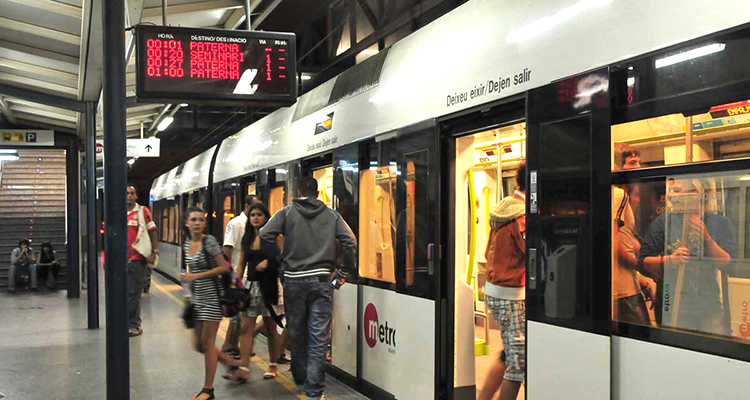
Metro Lines Valencia
This easy to read map of the metro in Valencia will help you navigate yourself throughout the city. Remember to buy a metro ticket beforehand and enjoy your stay in Valencia!
Lines of the Metro of Valencia to visit the most important places.
- Line 1: (Bétera – Villanueva Castellón) covers almost 100 km and is the longest.
- Line 2: (Llíria – Torrent Avinguda) has stops at strategic points such as the Turia Gardens and Plaza de España.
- Line 3: (Rafelbunyol – Aeroport) the most used and connects directly to the airport.
- Line 4: (Mas del Rosaries – Dr. Lluch) is a tram line.
- Line 5: (Maritim Serreria – Aeroport) connects the airport all the way to the seaport through the historic center.
- Line 6: (Tossal del Rei – Maritim Serreria) tram that connects the northern districts and the beach.
- Line 7: (Maritim Serreria – Torrent Avinguda) also has stops at strategic points such as Calle Colón and the AVE station Joaquín Sorolla.
- Line 8: (Maritim Serreria – Marina Reial Joan Carles I) tram along the shortest path near the port.
- Line 9: (Alboraya Peris Aragonesa Riba-roja de Turia) entered service March 2015.
Below you will find a map of Valencia metro with all the lines listed above in detail:
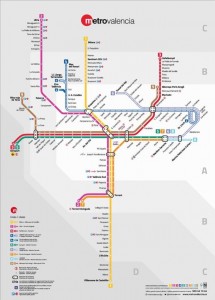
Related posts

How to get to the beaches in Valencia
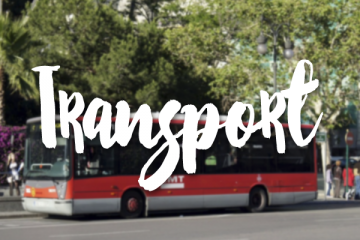
Valencia Transport

How to get to Bioparc Valencia
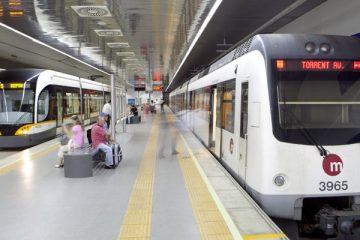

Metro Valencia

Transportation in Valencia – How to get around
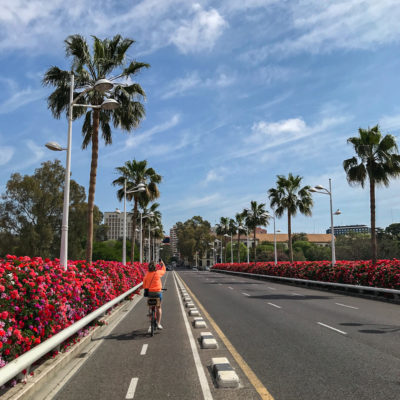
Valencia is one of the biggest cities in Spain, even though it’s not even a fourth the size of the capital, Madrid. You can perfectly explore the old city centre of Valencia on foot, and the larger area by bike. Public transport is also very well organised, so plenty of options to easily get around in Valencia!
TIP : The locations in this article are clickable and will take you to the corresponding marker on the map. You can find the map on the right of your screen, or by clicking the map icon on the bottom if you’re on mobile.
Wander around Valencia on foot
In less than half an hour you can cross the old city of Valencia , Ciutat Vella, on foot. It’s the perfect sized city centre to wander around on foot, getting lost in narrow streets, discovering all kinds of impressive buildings and cute restaurants. It’s also the cheapest way to get around in Valencia, and will contribute to getting your daily step goal!
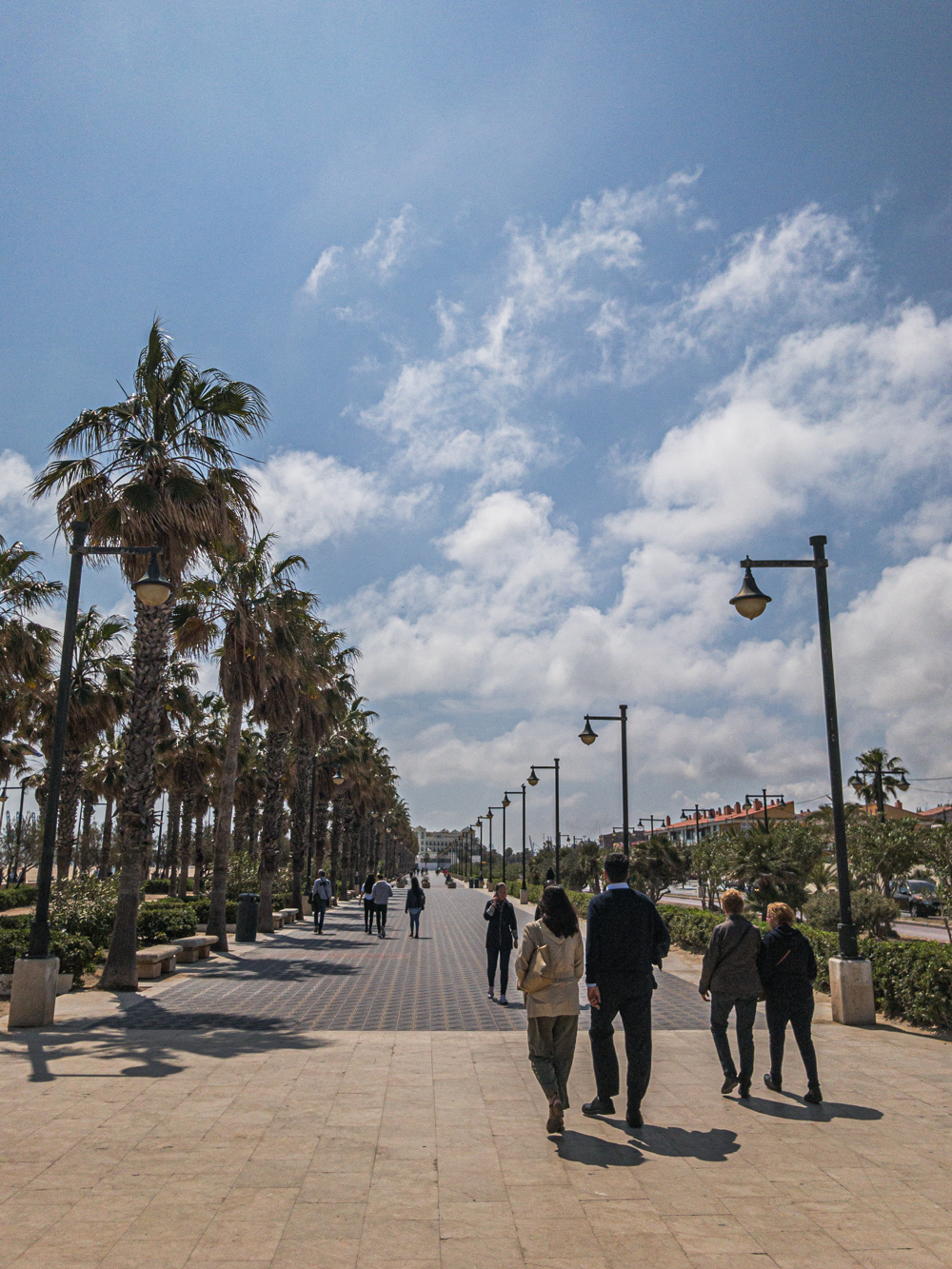
Explore Valencia by bike
Not all sights in Valencia are located within the old city though, so we suggest renting a bike for at least 1 day to explore the rest of Valencia.
The 9 km long Turia Park bending around the city is lovely for a bike ride, but there are well-maintained bike lanes throughout the (mainly flat) city as well.
We rented our bikes from our accommodation for €11 (~ $12.30) per bike for 24 hours . This included a lock and a wooden “basket” at the back of the bike. If we’d rented those bikes for more than a day, the price would have dropped to €9 (~ $10) per bike per day.
You can ask if your accommodation offers a bike rental service as well, or just walk into one of the many bike rental shops throughout Valencia.
TIP : The Valencia Tourist Card gets you a discount at selected bike rental shops in Valencia.
Make sure to lock your bike when parking it, preferably attaching it to the bike racks you can find along the streets. If you want to be sure, you can pay extra for insurance, but we didn’t.
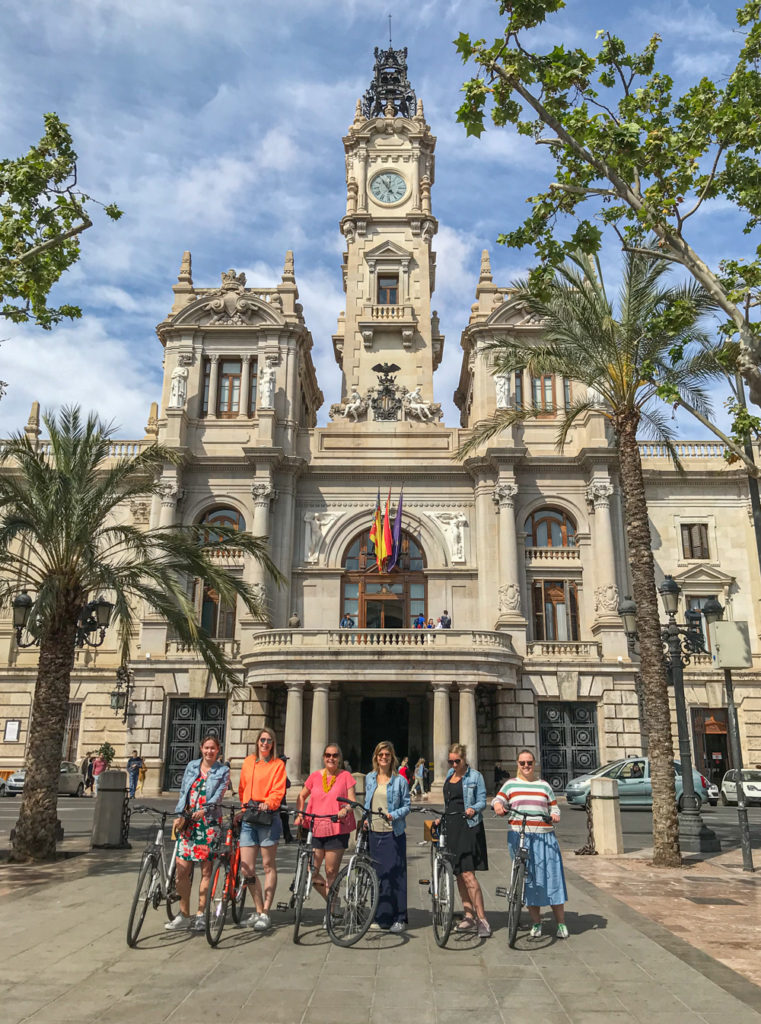
Use the Public Transport in Valencia
As mentioned before, public transportation in Valencia is very well organised. There are several metro lines running along the southern border of the old city, but we mainly used the extensive bus network to get around in Valencia.
Click here to skip to the overview of all public transport travel cards in Valencia .
Taking the metro in Valencia
The metro in Valencia is operated by Metrovalencia. As you can see on the map of Metrovalencia below, the metro (or subway) is useful to get to the outer edges of the city quickly, but doesn’t serve as many stops as the bus.
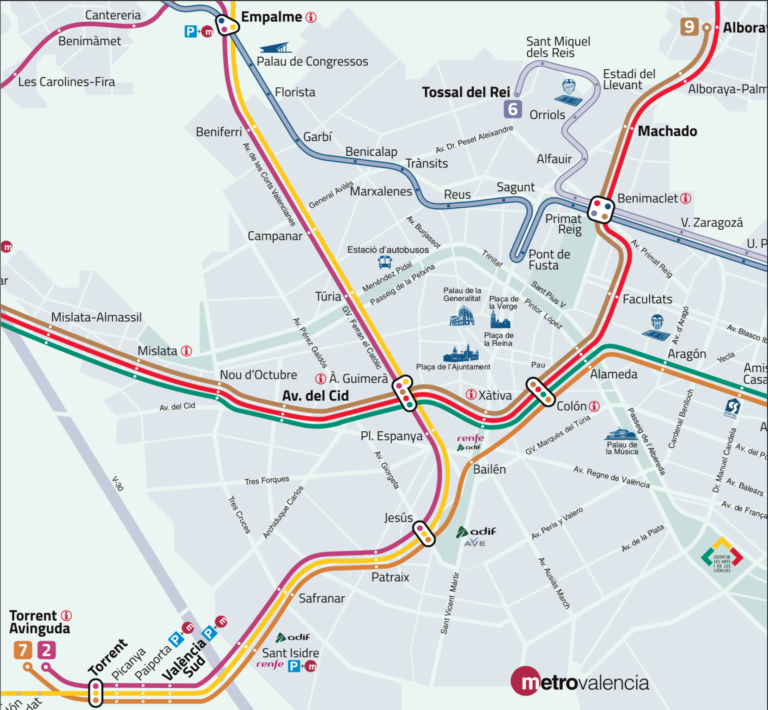
A single Valencia metro ticket will cost you €1.50 (~ $1.70) within one zone . Zone A is the biggest zone, enclosing most of Valencia. Outer districts of Valencia and destinations like the airport are in different zones. If your trip is through 2 zones or more, prices for a single ticket can rise up to €3.90 (~ $4.40).
A return fare is slightly cheaper than 2 single tickets, and after you validate the first trip, you have 24 hours before the return trip expires. However, if you plan on taking the metro more often, or with a group of people, you should consider buying a metro card.
There are 2 metro travel cards you can chose from. The TuiN Card has a minimum charge of €10, with single trips (within 1 zone) costing €0.72 (~ $0.81). The 1 zone Bonometro Card allows for 10 trips at €0.76 (~ $0.85) per trip.
Neither of these cards are personal, so they can be used for travelling with a group as well. Note that you have to pay an extra €2 (~ $2.20) for the physical card , which is rechargeable.
You can buy and top up these metro tickets and cards at the automatic vending machines in the subway stations and tram platforms, or in newspaper kiosks and tobacconist shops, like the franchise Tabacos. Validate it upon entering and exiting the metro.
The metro in Valencia operates between 4:00 and 23:30 on weekdays and between 5:00 and 00:30 on weekends.
You can find the entire map of all metro lines, the timetable and more information on the fares on the Metrovalencia website .
Taking the bus in Valencia
Buses in Valencia are operated by EMT (Emprasa Municipal de Transports). Their extensive network of bus routes efficiently services the entire city (and beyond). Each bus stop has information on the lines that stop there, and you can scan the QR code to see how far out the next bus is.
TIP : When you’re waiting for the bus, it’s custom to signal the bus driver to stop.
A standard Valencia bus ticket (one way) will cost you €1.50 (~ $1.70) and can only be bought with the bus driver upon entering the bus. However, if you’re planning on taking the bus more often, or with a group of people, you should consider buying a bus card.
There’s just 1 bus travel card available: the Bonobus Card . It costs €8.50 (~ $9.50) and includes 10 trips. You can change buses as many times as you want within the hour. That hour starts when you validate your card by putting it on the card reader in the bus. You still have to validate your card upon boarding the bus, but it won’t be charged.
This Bonobus Card isn’t personal, so it can be used for travelling with a group as well. Note that you have to pay an extra €2 (~ $2.20) for the physical card , which is rechargeable.
You can buy and top up the Bonobus Card in newspaper kiosks and tobacconist shops, like the franchise Tabacos. Once bought, you can also top it up via the EMT app, see below. Validate your card upon boarding the bus.
The buses in Valencia operate between 7:00 and 22:30. After that, there are night buses (blue N lines) taking over until 1:30 on weekdays and 3:30 on weekends.
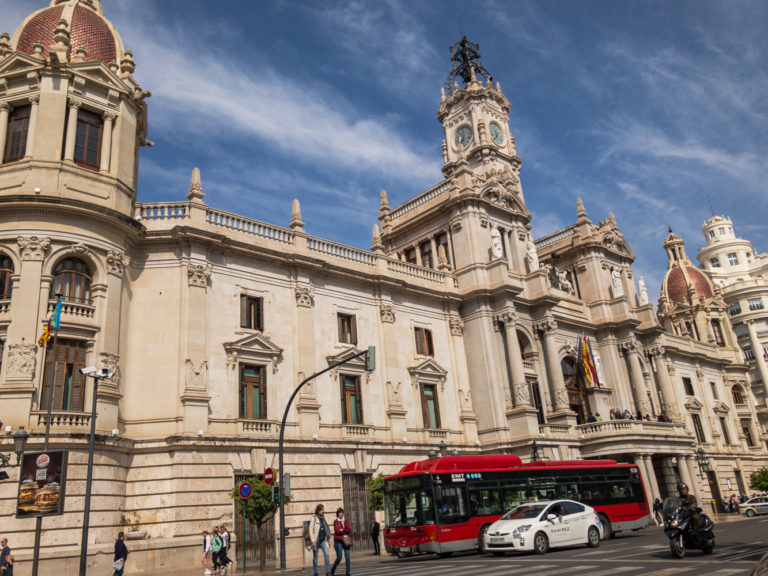
If you plan on taking the bus to get around in Valencia, we recommend downloading the EMT app , as the EMT website isn’t mobile friendly. You can search the app for buses based on bus stop or bus number, look for points of sale for travel cards, and connect your travel card to the app. You can then use it to check the number of trips available on the bus card, and recharge it. Take note that this won’t be available instantly after linking the card.
During our visit we often took the bus to get around in Valencia. We bought 1 Bonobus Card for a group of 6 friends, topping it up as needed. We were very pleased with the public transport in Valencia. The bus network is extensive, reliable, and buses run frequently.
You can find the entire map of all Valencia bus routes, the timetable and more information on the fares on the EMT website . Note that it’s not mobile friendly. If you’re on mobile, better download the EMT app.
Overview of all public transport cards in Valencia
Apart from the metro and bus cards we mentioned above, there are also travel cards that are valid on both the metro and bus network .
The Bono Travel Card is valid on the bus and metro zone A, which encloses the bigger part of Valencia. (Most tourists won’t need tickets for other metro zones.) It includes 10 trips and costs €9 (~ $10) . You can make as many connections as you want within 50 minutes after validating your card.
Should you want to visit the outer areas of Valencia, you can buy the Bono Travel Card Zone AB , which is valid on the bus, metro and Metrobus, which is the intercity bus. It includes 10 trips and costs €15.50 (~ $17.40) . You can transfer between buses and the metro without extra charge for 90 minutes after validating your card.
The above 2 travel cards aren’t personal, so can be used for travelling with a group as well. The T1, T2, and T3 travel cards on the other hand are personal cards, valid for unlimited travel for 1 person over respectively 1, 2 or 3 days. These cards are valid on the bus and metro zone A, and cost respectively €4 (~ $4.50), €6.70 (~ $7.50), €9.70 (~ $10.90) . Take note that it’s 1 day, not 24 hours.
To keep things clear, we made this overview of all public transport cards in Valencia:
Note that the price for the physical card, called the Mobilis Card, isn’t included here. It costs another €2 and is rechargeable. You can buy these public transport cards at automatic vending machines in metro stations, and in newspaper kiosks and tobacconist shops, like the franchise Tobacos.
Now, which card to choose? In our experience, the Bonobus Travel Card is the best option. First of all, the bus network services way more stops than the metro lines.
Secondly, it’s still cheaper than the T1, T2, or T3 travel card, even though unlimited travel is a tempting offer. You’ll have to do 4 trips (5 with T1) per person per day for it to be cheaper, but that’ll barely save you 5 cents a trip. To save up to 20 cents a trip, you’ll have to do 5 trips a day, which is highly unlikely if you plan your visit right.
Depending on where you are planning to go and what you’re planning to visit, the Valencia Tourist Card can be a great option too, as it includes unlimited travel over 24, 48, or 72 hours, combined with free entrance to certain attractions and discounts on things like museums, shops and restaurants. The Valencia Tourist Card is valid on the bus and metro, including the airport line.
Taking a taxi in Valencia
If you’re not that into public transport, or need to be somewhere no bus drives, you can always take a taxi. Just hail one, get in, and have the address of your destination ready on your phone or a piece of paper, as not all taxi drivers speak English. All taxis in Valencia are white, available 24/7 and use meters, so no need to haggle.
Hop on (and off) the Valencia Tourist Bus
Nearly every (big) city has an open-top hop-on hop-off tourist bus, and Valencia does too. The Valencia Tourist Bus is actually a city tour on wheels, taking you along all major tourist attractions in Valencia. There’s an audio guide on the bus (available in different languages) and you can hop on and off as you want.
The Valencia Tourist Bus drives 2 different routes : the Maritime Route and the Historic Route. Both of these tourist bus routes take 90 minutes, if you don’t hop off, and pass Plaza de la Reina and the Museum of Fine Arts , so you can change routes there.
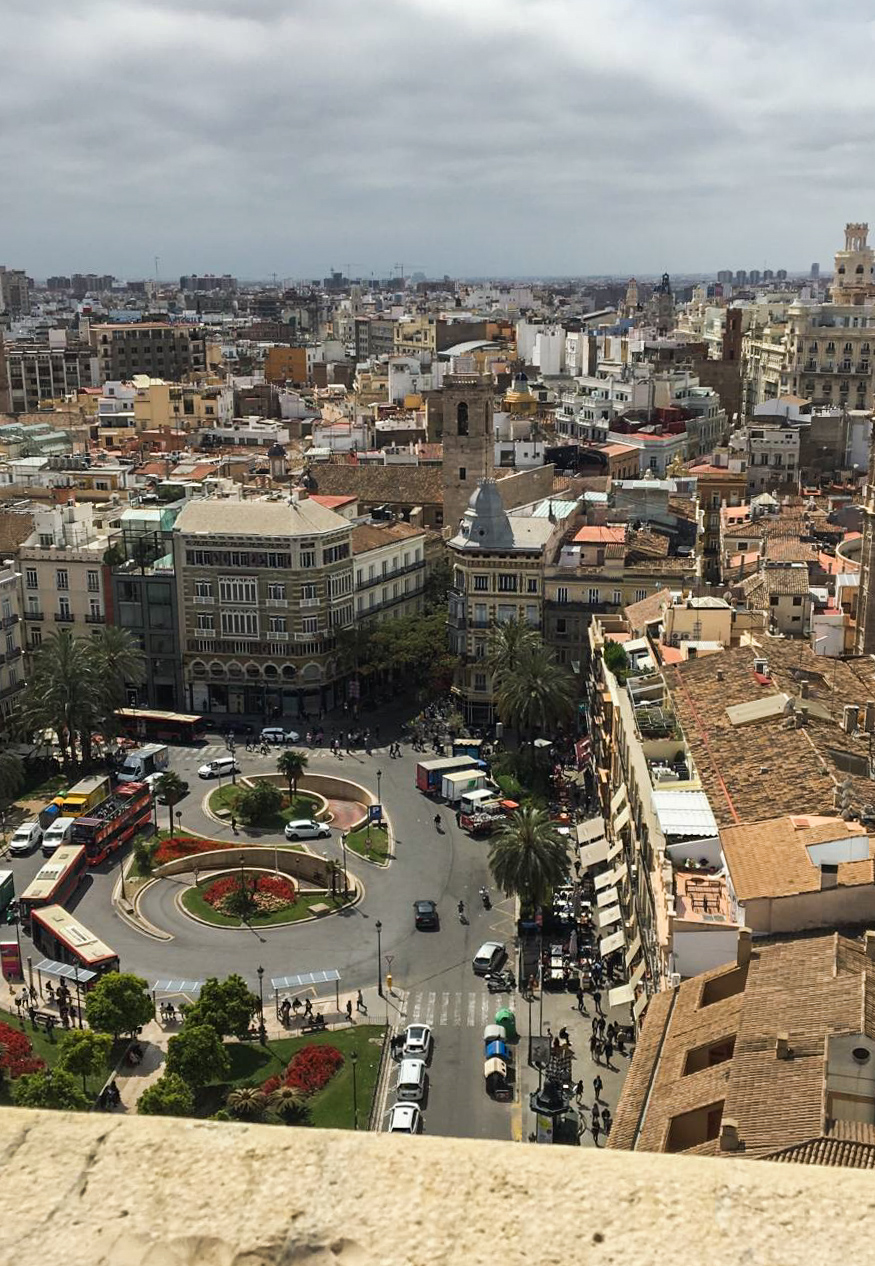
The Maritime Route starts from Plaza de la Reina and drives via City of Arts and Sciences to La Marina , the port of Valencia.
The Historic Route starts from Plaza de la Reina as well, but drives in the other direction, via the IVAM , the Centre for Modern Art, to the convention centre of Valencia .
Note that each last Sunday of the month, when Plaza del Ayuntamiento becomes a pedestrian zone, the routes slightly differ, with a drop in prices as well. Check out the official Valencia Bus Turistic website for more information.
The Valencia Tourist Bus drives between 9:30 and 21:00 all year round. Except in July in August, when service hours are extended another hour, ’til 22:00. Find the exact timetables on the official Valencia Bus Turistic website .
There are 2 types of tickets for the Valencia Tourist Bus: a 24 hour and a 48 hour ticket. Both of these bus tickets include an audio guide in different languages, but not the entrance fee to the tourist attractions you’ll pass. You can however buy a combination ticket for the Valencia City Bus Tour and Oceanogràfic for example.
A ticket allows you to hop on and off as much as you like , changing between the 2 Valencia Tourist Bus routes. You can choose between a 24 hour ticket and an 48 hour ticket.
TIP : The Valencia Tourist Card gets you a discount on these Valencia city bus tour tickets.

Our conclusion: Valencia is a great city to explore on foot or by bike, but if you’re staying a bit out of the city centre for example, you can easily take the bus as well.
We often took the bus to the city centre, before continuing on foot, but renting a bike for a day or two was a lot of fun as well. How will you be getting around in Valencia?
Like it? Pin it! Did you find this post helpful? Help us spread the word by sharing this post or pinning the following image.
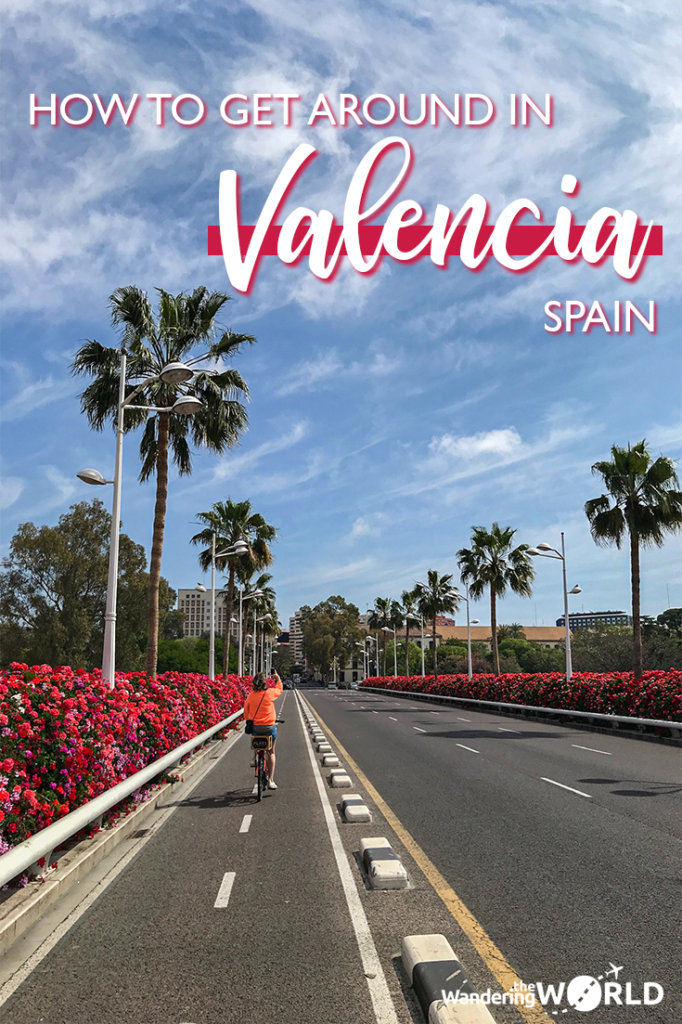
Leave a Reply Cancel reply
Your email address will not be published. Required fields are marked *
This site uses Akismet to reduce spam. Learn how your comment data is processed .
Valencia Travel Guide
The metro and tram in Valencia
Valencia’s urban rail network counts a total of 146 stations, divided into ten active lines. With its total length of 162 km, it covers Valencia’s urban area thoroughly and it is a great way to move around the city.

Public transport discounts - 1st September to 31st December 2022
The Valencian government has introduced a discount on multi-journey transport passes.
The discount brings the price of a SUMA 10 pass (valid for metro, tram, buses, and railways) down to €5.60 (one zone), €8.40 (two zones), and €14.00 (three zones).
Single tickets remain the same.
Free Transport Under 30 - 9th October - 31st December 2022
Free public transport (metro, trams, and buses) is available in Valencia for people under 30.
To benefit from this initiative, users have to request their free transport card online. The only prerequisite is a Spanish DNI or NIE as proof of age.
Valencia’s urban rail system (Metrovalencia) connects various parts of the city with the surrounding towns and areas, Manises Airport included. Metro and tram lines are both considered to be part of this system, thus sharing the same fare system.

While only nine stations are close to the old city centre , the network is continuously expanding. In fact, there are at least two more lines planned to open in the upcoming years.
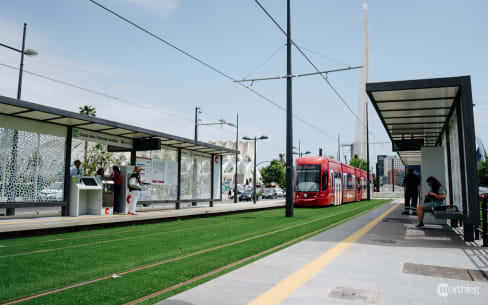
The urban rail system is a great way to move around Valencia, especially if you need to move from one end of the city to the other.
The service is frequent (a train every five or ten minutes) and efficient, so you will be at your destination quickly, and without worrying about traffic. The trains are safe, clean and relatively new, with staff and security available at many stations in case you have any doubts or need help purchasing a ticket.
This is certainly your best option if you are moving between the airport and the city . However, if you are moving around the old quarters (within the old city walls), you will find there aren’t as many stops available as in other parts of Valencia. In this case, you might want to opt for a bus or for a private means of transport, such as a bicycle or a moped .
Valencia transport zones
For public transport use, the city is divided into three concentric areas ( zonas in Spanish) and one overlap area.
- Zone A is the biggest and most central one. It covers the city with its most important sightseeing spots, the old centre, the newer and trendy neighbourhoods, as well as the beach. The tram service runs mainly in this area. You will most likely be moving around zone A on your visit.
- Zone A-B is the overlap area. Its function is to keep prices low for those that travel between bordering zones. People moving from these areas to the nearby zones A or B (and vice versa) will be able to get single-zone tickets. The municipalities belonging to this area are those of l’Horta - the larger urban area of Valencia.
- Zone B is the area directly around A. It covers mostly small towns and municipalities belonging to the metropolitan areas of Camp de Turia (northeast of the city), Camp de Morvedre (north of the city), and Ribera (south of the city). You are not likely to visit this area, as it is of little tourist interest.
- Zone C is equivalent to the airport. It serves the purpose of separating the airport from all other areas.

More related activities...

You might also be interested in...

Divided into 19 districts, the city of Valencia preserves its identity in its many neighbourhoods, each with a different history, style, and essence.

The North Station is one of Valencia’s Art Nouveau landmarks and a sign of the city’s 20th-century expansion, while still maintaining its ties to local traditions and the Huerta.

Fallas is an incredibly rooted tradition in Valencia, but when did it become as we know it today? What are its origins? How has it changed over time?

The final grand firework display before the last day of Fallas. Twenty minutes of dancing colours and lights exploding in the dark Valencian sky

During Fallas the party is in the streets. Valencia is set ablaze by dozens of open-air parties and small concerts, the verbenas and discomóviles

The most charming places in Valencia, where you’ll feel like you’ve fallen into the pages of a fairytale.

Using the Valencia Metro – How to Save Money and Travel More Easily

I’ve been living in Valencia for over three years now. And I think it took me at least a year to figure out all the different metro ticket options and to learn about the TuiN Card for Valencia’s metro .
Even though the TuiN card is a standard Valencia metro ticket, I found out many people who have lived here for years don’t know about using this card on the Valencia metro. And it can save you a lot of money!
But this TuiN card doesn’t only save you money, it also makes using the Valencia Metro easier .
So, whether you are visiting Valencia or are living here, read this article to find out why and how you should use Valencia’s TuiN card.
Note: in 2022 Valencia launched a new public transport card called the SUMA . With this card you can use the metro, the bus and the regional trains. Prices of the SUMA card are similar to the TUIN card and I will therefore mention how the SUMA card works, and how it compares to the TuiN card, in this article as well.
Using the Metro in Valencia

Valencia’s Metro is clean, safe and reliable.
There are 10 metro lines. Some of the lines are actually partially or entirely above ground, and are technically trams but they are part of the same network and therefore work with the same metro tickets.
To be honest, I don’t use the Valencia metro a lot. It’s how I get from Valencia airport to the city center, but the rest of the time I mainly walk, or sometimes cycle, to get around the city.
This is actually one of the things I love about Valencia: it’s a very walkable city with a very compact center.
But, before I tell you more about the TuiN card, let me try to give a short explanation of how to use the metro in Valencia.
This is the official map of the metro lines in Valencia:
(note: Valencia has changed the zoning of the metro in 2022. You might still find old maps with zones A-D. The below map, with only three zones, is the correct map for 2024)

As you can see there are two lines (line 3 and 5) that go from the airport to the city center.
I would say the metro is the best form of transportation from Valencia airport to the city center.
The only real alternative is taking a taxi but that, of course, costs a lot more. There is one bus from the airport to the city center as well, but the metro is definitely more convenient.
And, as I will explain below, with the TuiN card or the SUMA you pay only 2 Euros to get from Valencia airport to the city center!
For any other use of the metro in Valencia I’d say just check Google Maps. Type in your destination and Google Maps will tell you which, if any, metro line you can take.
Valencia Metro Tickets & Metro Zones

Have another look at the Valencia metro map above. You’ll see the letters A and B, and a ‘+’ for the airport. Those are the different zones Valencia’s Metro system uses.
Depending on where you plan to go to you can buy tickets for different zones. Your standard ticket option is a one-way ticket, and you’d buy two of those if you plan to return as well (there is no special rate for round-trip tickets in Valencia).
But, a cheaper option to use the Valencia metro is to not buy a specific ticket but instead load credit on your metro card. And that is essentially what the TuiN and SUMA cards are: two different type of metro cards. Or better said, public transport cards, because the SUMA card can be used on other forms of public transport as well, but more about that later.
Valencia Metro tickets and the TuiN and SUMA cards can be bought at any metro station, either through a ticket machine or from the ticket office.
I’ll share several other tips for using the metro in Valencia at the end of this article, but let’s talk about the TuiN card first. And, I’ll follow that with information about the SUMA card so that you can compare the two options.
Why You Should Use the TuiN Card in Valencia

First of all, although people call this the TuiN card (and even the official Metro Valencia website calls it this), it’s not actually a different card.
It’s just a way of loading money onto a standard metro card. It’s exactly the same card you’d use for a one-way ticket.
The short answer to why you should choose the TuiN option when using the metro in Valencia is: the TuiN card allows you to use the entire Valencia metro & tram network with just one card and it’s a lot cheaper than buying single tickets.
But, let me describe the pros and cons of the TuiN card in Valencia in a bit more detail.
Pros of Using Valencia’s TuiN Card
1. going to the airport costs just € 2 instead of € 4.80 or € 5.80.
When I first moved to Valencia I did what most tourists do when they arrive at Valencia airport: walk to the ticket office or one of the ticket machines and buy a one-way or return ticket into the city.
This way you pay € 5.80 for a one-way ticket into the city (€ 4.80 + € 1 for the card), or € 10.60 for a return ticket (€ 9.60 + € 1 for the card).
If you’d buy a TuiN card each ride from or to the airport would cost you only € 2, plus a one-time fee of € 1 for the card.
The first thing most visitors don’t know is that the paper metro ticket you receive is actually reusable and has cost you € 1.00. So, don’t throw it out! The next time you want to buy a metro ticket, either hand this ticket to the ticket vendor or insert it into the ticket slot in the ticket machine. This way your new metro ride(s) will be loaded on the existing ticket. You save € 1.00 and waste less paper.
Tip: if you are staying in Valencia longer you can ask the ticket office for a more durable plastic card. The card costs € 2.00 and cannot be obtained at a ticket machine.
2. All Your Metro & Tram Trips in Valencia Turn Out Cheaper
Ok, this used to be a big advantage before the introduction of the SUMA card in 2022. Now prices of the TuiN card are actually the same as those of the SUMA card.
I’ll explain more about the SUMA card later.
TuiN prices are a lot lower than that of one-way tickets which still makes the TuiN the cheap option for using the Valencia metro.
See the price comparison between the different metro ticket options further down the article.
Also Read: How to Save Money When Traveling
3. You Don’t Need a Different Card for Different Zones Anymore
This, to me, is the biggest advantage of the TuiN card .
Like most of my friends in Valencia I used to have various metro cards: one for traveling within zone A, one for going to the airport, and for a while I had one for zone AB too.
This is because the SUMA (and before the 2022 changes the Bonometro ) is substantially cheaper than just buying a one-way ticket. But, each metro card only allows a SUMA for 1 type of metro ticket.
It’s annoying! I never liked keeping track of my balance on all the different cards and I was always worried I would end up taking the metro from a different zone and then my card wouldn’t work.
So, having one TuiN card that can be used on the entire metro & tram network is definitely easier!
4. You Can Use One Card for the Whole Family
This is actually a useful tip for both the SUMA and the TuiN; you can use the same card for multiple people. The TuiN card can be used for up to 60 people!
So, if you plan to travel together as a group or family, just buy one metro card, load enough TuiN credit on there, and use the one card to check everyone in and out when using the metro or tram.
Note: if you decide to buy a simple one-way ticket instead of the TuiN, you can load four of those on one Valencia metro card. So even this way you can use one card for multiple people.
5. You Travel for Free Once You’ve Reached a Monthly Limit
This is a nice bonus if you use the metro a lot. But, I do mean A LOT, since the monthly limits are high.
Monthly Limits:
- 1 zone: € 35
- 2 zones: € 53
- 3 zones: € 53
How Does This Work?
Once you have spent 35 Euros within one calendar month, all your travels for the rest of the month within one zone are free of charge. You will still pay the normal TuiN rates when you travel in 2 or more zones.
Then, once you have spent 53 Euros, your travels for the rest of the month within 2 and 3 zones also become free of charge.
Again, with Valencia being such a walkable city I don’t think many people spend this type of money on the metro, but if you do, this is nice to know!
Note: only your own trips count towards this free travel. If you use one TuiN card for more passengers at the same time, only one counts towards your monthly balance. The fare per journey for your companions will be the same as any TuiN cardholder but only you will be able to take advantage of free journeys once you have reached the monthly threshold.
Cons of Using Valencia’s TuiN Card
1. the tuin card can only be used on the metro and tram.
The TuiN card only works on the metro and tram lines. If you, for example, need a metro ride and a bus ride to get to your destination you will need a separate ticket for the bus.
The SUMA card is the one card that combines all of Valencia’s public transport.
2. You Have to Load Your Card With a Minimum of 5 Euros
If you are only visiting Valencia for a few days , there is a chance you won’t spend 5 Euros on the metro.
For example, if you are visiting Valencia and are staying in the city center, you might only use the metro to get around in zone A. At € 1.50 per trip, you could take three metro rides and it would still be cheaper to buy one-way tickets.
But, add to that just one ride to the airport at € 4.80 and you’re much better off getting a TuiN card. Even more so when you are traveling with other people, the TuiN very quickly becomes the cheap way to use the Valencia metro.
Futher on in this article I share a comparison of prices for the TuiN, SUMA, and one-way tickets, to give you a better idea of what your metro usage in Valencia would cost.
Note: the maximum you can load on the TuiN card at one time is 100 Euros.
3. You Can’t Load TuiN and Bonobus on One Metro Card
There is a 10-ride package for the bus called the Bonobus . This makes using the bus a lot cheaper than buying one-way tickets.
If you’ve been in Valencia for a while you might have gotten used to loading the old Bonometro option (before SUMA was introduced) and the Bonobus on the same card. Unfortunately, TuiN cannot be combined with the Bonobus so you’ll need a separate card for the bus.
If you’ve never been to Valencia before just ignore this comment and know that you’ll get a card exclusively for the metro, on which you’ll load your TuiN credit.
But, these are really the only minor downsides to using the TuiN card I can think of. Because, apart from special memberships (such as monthly ones or ones for retirees in Valencia ) the TuiN really is the cheap and easy way to use Valencia’s Metro and Tram system.
The TuiN Card versus the SUMA Card

The introduction of the SUMA card as a general card for public transport in Valencia has simplified the Valencia metro, thankfully.
There used to be all sorts of options for using the metro including the Bonometro and discounted round trip tickets.
The Bonometro (10 one-way tickets to be used within one zone) is replaced by the Suma 10. Discounted round-trip tickets have disappeared altogether.
If you choose the SUMA card to use Valencia’s metro you’ll have three standard options:
- You buy a SUMA 10: 10 one-way tickets for the zone(s) of your choice.
- You buy a monthly plan (very unlikely because you’ll have to use public transport a lot to make that worth it).
- You buy a 1, 2 or 3 day ticket that gives you unlimited travel in 2 or 3 zones (only useful if you plan to use the metro a lot during these days).
There is one big advantage to having a SUMA card instead of a TuiN card and that is the fact that the SUMA card can be used on all public transport. You can use it on the metro, the tram, the bus, and the local trains (called cercanias ).
But, the disadvantage of the SUMA card is that you have to choose for which zone(s) you want to use your card. If you buy the SUMA 10 for 1 zone then you can’t use it to go to the airport, for example.
So unless you are planning to use different forms of public transport in Valencia the TuiN card is still your best option for the Valencia metro and tram . The TuiN card offers the same prices as the SUMA but when you put credit on your TuiN card you can use it for any zone, and switch between zones as much as you want.
If you do choose to go for the SUMA card instead of the TuiN card, getting these cards works in similar ways, which I will describe next.
How to Get the TuiN Card

You can get the TuiN card either at one of the ticket offices inside the metro stations or at a ticket machine .
If you use a ticket office, just ask for a ‘TuiN Card with 10 Euro’ (or whichever amount you want).
Most people at the ticket office speak (some) English so you can just ask for this in English. But if you happen to catch someone who doesn’t speak English, Google Translate is your friend!
If you use a ticket machine, click on the flags on the home screen to change it to English. Then you can choose ‘Buy’ or ‘Recharge’. If you already have a metro card, insert it and choose ‘Recharge’. If you don’t have a metro card, choose ‘Buy’ and you’ll be charged € 1 extra once you finish your order to receive your TuiN or SUMA credit loaded onto a paper metro card.
After choosing ‘Buy’ or ‘Recharge’ you’ll see the screen pictured above. Click on ‘CARD Tuin’ to get Tuin credit, or choose ‘SUMA 10’ if you want to load SUMA credit on your card for a zone of your choice.
As you can see you can also choose ‘Airport’ but that means paying the previously mentioned higher price of €4.80 each way.
Note: If you are using an existing card, make sure there are no other metro or bus tickets loaded on the card anymore. This is because different travel plans cannot be combined on one card . If you do have some credit left and want to switch to TuiN or SUMA, just go to a ticket office and let them sort it out for you.
Comparing Prices: Tuin Card Valencia vs One Way Tickets & SUMA Card

To give you an idea of how much you would save by using the TuiN card, this is an overview of the standard Valencia metro tickets.
Note: MetroValencia is offering a temporary discount of 50% on its ticket prices. This discount is given on any credit you load onto a TuiN or SUMA card. Prices shown below are the normal prices. You will receive a 50% discount on those. This is a temporary financial aid, which is currently set to end on January 31st 2025.
1 zone one-way ticket: € 1.50 TuiN: € 0.80 (to reload your card you have to add a minimum of €5) SUMA: € 0.80 (you load the SUMA 10 on your card which costs €8 for 1 zone)
2 zones one-way ticket: € 2.80 TuiN: € 1.20 (to reload your card you have to add a minimum of €5) SUMA: € 1.20 (you load the SUMA 10 on your card which costs €12 for 2 zones)
3 zones one-way ticket: € 4.80 TuiN: € 2 (to reload your card you have to add a minimum of €5) SUMA: € 2 (you load the SUMA 10 on your card which costs €20 for 3 zones)
This shows another advantage of the TuiN card for using Valencia’s metro: you only have to add 5 euros. If you want to get the SUMA card for 3 zones it instantly costs you 20 euros. Of course that 20 euros gives you credit for 10 trips, but how often do you go to the airport? That balance might sit on your card for a very long time.
Tip: Are you under 31 and want to save even more on Valencia metro tickets? There is a ‘TuiN Jove’ that gives passengers under 31 an additional 15% discount . Allegedly you only have to show a document proving your age and have a passport-sized photo to apply for this. I haven’t tested it since I’m not young enough anymore… 🙁
Tips For Using the Metro in Valencia

1. Use the Metro Valencia App
I’d recommend using the Metro Valencia App to check metro times.
Not all metros run very frequently and the metro doesn’t run all night. So the app will keep you from waiting too long at the metro station and from missing that last metro home.
The official Metro Valencia App can be downloaded in the App Store here or in the Google Play Store here .
Alternatively, Google Maps is also generally good at showing metro times.
2. You Can Recharge Your TuiN Card Online
Apart from recharging your TuiN card at a ticket machine or ticket office inside any metro station, you can also recharge your card online .
To be able to do this you do however have to create an account online and register your card.
To recharge your SUMA card online you have to download the RecargaSUMA app.
3. Kids Under 10 Travel For Free!
No matter what metro ticket you choose, up to two kids per adult are always allowed to travel for free, as long as they are under the age of 10.
4. A Tip For Traveling With a Suitcase

To enter the metro platforms you have to go through electric gates which you open with your metro card. If you are traveling with a suitcase, use the gates with the disabled signs. They are wider plus they open and close slower, which means less risk that your luggage gets stuck!
Is the Metro in Valencia Worth Using at All?
As I said, I don’t use the metro all that much.
If you are looking for transportation from Valencia airport to the city center the metro is definitely your best option. But if you are staying in the center of Valencia you will hardly need the metro.
So if you ask me how to get from Valencia airport to the city center I’d definitely say by metro. After that, you might use the tram to get to the beach and the metro once or twice to get to locations further away from the center.
But getting around the city itself you’d most likely do on foot or by bicycle.
Also Read: What to See & Do on a Short Trip to Valencia
Alternative to Valencia Metro Tickets: the Valencia Tourist Card
Love rooftop bars? Check out some rooftop bars in Valencia
Are you planning a short visit to Valencia and want to see and do as much as possible? Then the Valencia Tourist Card might be an option.
The Valencia Tourist Card gives you unlimited access to the bus, metro, and tram, including your trip from and to the airport.
Apart from that, it gives you free entry to municipal museums such as La Lonja de la Seda (a must-visit!) and several others.
And the card gives you discounts on many of the main tourist attractions in Valencia such as the City of Arts & Sciences, the Hop-on Hop-off Bus, several guided tours and more.
You can buy 3 versions of the Valencia Tourist Card : one for 24, 48, or 72 hours, depending on the length of your stay.
Special Thanks to Metro Valencia!
Now, anyone who has lived in Spain, and probably also most people who have only visited Spain, know that Spain isn’t the most efficient country…
Also Read: Fun, Surprising & Shocking Facts About Spain
It took me over a month of research, and interviews with four different MetroValencia officials to get all of this information!
Even to many of the MetroValencia staff some of the metro rates, tickets, and best travel options seem unclear. But, they were all incredibly helpful and that deserves a special thank you!
So, whether you are visiting Valencia or living here, I hope my explanation of the Valencia metro and the different ticket options was useful.
For More Information About Valencia, Also Read:
- Where to Stay in Valencia – the Best Neighborhoods & Hotels
- What to Do in Valencia on a Short Visit
- What to See and Do in Valencia With Kids
- Celebrating Las Fallas in Valencia – What You Need to Know
- Taking a Paella Cooking Class in Valencia – Recipe Included
- Where to Eat Paella in Valencia – 7 of the Best Restaurants
- Authentic Chinese Food in Valencia: A Tour of Valencia’s Chinatown
- The Best Rooftop Bars in Valencia
- Interview With an Expat About Moving to and Living in Valencia
- Popular Neighborhoods to Live in Valencia
- Interview With 4 Retirees About Retiring in Valencia
Like this article about Valencia metro cards? Pin it!

This post about the Tuin card Valencia contains affiliate links. I may receive a commission for purchases made through these links, at no additional cost to you.
65 thoughts on “Using the Valencia Metro – How to Save Money and Travel More Easily”
Hi, Sanne! Thanks for this article!!! I keep seeing on the Metro website, Zones A, B, C, and D, but the map only shows A, B, and +. Now I understand that the map page isn’t as updated as the fares page is.
We traveled to Valencia two years ago but used the tourist pass for the five days we were there. We are coming back for a week in February of 25 to check it out again, with the plan of living there for a year (at least) beginning in 26. We will probably do the monthly SUMA card for that week, but only because we want to be able to go pretty much anywhere for that week and check out areas of town, be it by bus or tube or tram. At least, we now know our options, thanks to your article. Thanks, again!
Thanks Timmy! I appreciate you taking the time to write this and am happy you found my article helpful 🙂 Enjoy your next visit to Valencia. It’s a great idea to explore as many different parts of the city as you can before you decide where you want to live!
How do you actually use one suma 10 Card for two people? Do you have to swipe it two times when entering the bus? Thanks!
Yes exactly, you swipe it for each person when you enter the bus. So if you’re 2 people you swipe it twice, and you’ll see it deduct 1 from your remaining balance each time you swipe it.
Thank you so much for this clear article, I have been using SUMA 10 for my first week but may now change to Tuin. But I have a question about SUMA – in more remote stations like L’Eliana there are no barriers. Do you need to swipe the SUMA card on the machines on the platforms on arrival as well as departure, or are you using up an extra journey unnecessary by doing that? (I’ve been swiping both ends!)
Hi Roy, Good question. I contacted Metrovalencia to double check this. Their answer: when there’s no barrier, the only type of card you do have to swipe again on departures is the TuiN card. And yes, unfortunately, if you’ve been swiping the SUMA card at both ends they confirmed that this takes an extra journey from your SUMA balance.
Thank you, I really appreaciate the effort of putting all this useful information together! It looks as if we’d end up with a TuiN card for travelling from and to the airport and a SUMA 10 (maybe monthly, have to calculate…) for the inner zone as we will likely use the bus, too.
Quick question though as I maybe don’t fully understand the concept of various “zones” on the Suma card. Let’s say I have a AB+ Suma card 10 for 20,-€. What if I travelled only within zone A? The deduction on the card would be ten rides for 0,80€ each = 8,- Euros, correct? Would 12,- Euros remain on the card, but are they then somehow not “associated” to a (upcoming) ride? Or will any ride using an AB+ card cost you 2,- Euros?
Or is this overthinking and the only consequence of the zones concept is the amount you have to load on the card but you could still use it as a flexible currency for rides in whatever zones. Confusing… or maybe it’s just me! 🙂
Hi Sven, No you’re not overthinking it 🙂 That’s exactly the problem with the SUMA card. If you buy one for zone AB+ because occasionally you travel that distance, now when you use that card while traveling just within zone A you still pay the standard AB+ zone fare, which is 2 Euros. That’s why some people have multiple SUMA cards for different zones, or use TuiN for the metro and a Bonobus card for the bus. So yeah, annoying, confusing and what’s best for you depends on your personal situation. I hope this explains it a bit though!
Yes, it does, thank you so much Sanne!
Hi, Thank you for helping me understand Valencia metro! We are a group of 5 travelling for a weekend to valencia. I assume, we would only be using metro to and fro airport as we are staying in the city centre. which would be the best card for us to buy when we get to valencia airport? Tuin or SUMA?? Thank you
Hi Star, In your case you could get either because: – If you want to use the SUMA from the airport you need to get the option for 3 zones (Suma AB+) and buy a package of 10 rides. That costs 20 euros (minus the current 50% discount). For you this is perfect because you’re 5 people who will all do 2 metro rides so you’ll use that up exactly. – If you buy a TuiN card you can load it with a minimum of 5 Euros credit. But, each ride from and to the airport is 2 Euros, you need 5×2 rides so that’s still the exact same 20 Euros (note: with the discount now it’s 10 Euros so make sure to only put 10 Euros on the card as long as the discount is available).
Note: when buying the metro card you’ll pay an additional 1 euro for a paper card or 2 euro for a plastic card.
I would still choose a Tuin card though. If you’re staying in the center, you, or anyone in your group might decide to take the metro to the beach, or for a short distance around the city. You only have to put 5 Euros extra credit on the Tuin card whereas to use your SUMA card again you’d have to add a full package of 10 rides again costing you 20 Euros (10 currently after the discount) because you’re card is still loaded with the more expensive SUMA AB+ zone and you can’t add credit for a cheaper Suma zone on the same card.
I hope this helps. Enjoy Valencia!
Thank you for your help and guidance. We had a good holiday in Valencia and used the Tuin card for travel.
Excellent article, managed to change to the Suma Card on one of the machines at the train station last time I was in Valencia. Since I am on vacation almost once a year in Valencia I bought one of those plastic cards back in 2019. Do you know if they expire? It seems that last time I topped up with the Suma app I discovered that it seems that the card expires in may of 2024 – so maybe they “just” have a lifetime of 5 years. Hmm…
Hi Jack, I just contacted Metrovalencia to check. They say cards do not expire. I’ve seen an expiration date mentioned as well so it’s a little confusing but if they say it doesn’t, definitely don’t throw out the card and try to use it even if you get back after May 2024.
We are not able to carry our luggage up or down stairs, are there escalators at Xativa and at the Airport both to and from platforms and to the street level? Thank you
Hi Ros, Yes, the metro station at the airport can be reached using an escalator and at Xativa station there’s an escalator up from the platform an then an elevator taking you to street level.
Great information. Since I will be in a part where is no metro, I will be using SUMA 10. Does with SUMA 10 the 90/150 minute journey limit apply on buses too? Or if I use bus and metro to my destination?
Hi Dusan, thanks! And yes, I checked Valencia’s transportation website and, loosely translated, it states: When using SUMA 10 the free transfer time is 90 minutes from the first time you check in if it’s a journey within one zone. If you travel in 2, 3 or 4 zones, it’s 110, 130 or 140 minutes, respectively. So as far as I understand that means it’s the same whether you use the metro, the bus, or both.
Thanks! Now I’m a little confused about the number of allowed transfers. Is number of transfers limited within one journey?
Does the ticket need to be validated again on another bus, metro or tram within same journey?
I know, it’s quite a confusing system and there’s a lot of incomplete information online about using public transportation in Valencia.
Valencia’s government website GVA.es states that the number of transfers is unlimited, as long as you stay within the zone(s) you have a Suma card for, and the allowed time limit.
And yes, you do need to tap your card again when you go on another bus or tram and when you go through any of the gates at metro stations (that one is easy, you simply can’t get through any of the gates without tapping your card so there won’t be any confusion there).
Impossible for a tourist to register the metro card online. Keeps asking for passport details but doesn’t accept freeform text of passport number. Very poor indeed
Hi John, unfortunately I’m not surprised that you experienced that. However, I just logged into my Metro Valencia account to check whether I used my Spanish NIE, and it doesn’t seem to have my NIE-number on file, which makes me think I registered without it. So just to make sure, did you use this website to register: https://www.metrovalencia.es/en/ There click on ‘Personal Zone’ and then register a new account. Again, you’re probably right because I’ve definitely experienced difficulties trying to use my passport number in Spanish systems, but in case you went through a different page or app, try that. Otherwise, yes it is annoying, it means you’ll have to check your balance and top up at a metro station.
Sounds like an unnecessarily complicated system! London’s Oyster card and Sydney’s Opal card both much easier to use. Lot’s of information in this article, brave try at explaining the options but it’s not clear how to buy or top up either of the cards. The article would benefit from editing to come up with a simplified succinct explanation.
Oh I wish we had the same easy system as London’s Oyster card here in Valencia! 🙁
How to buy and top up the TuiN card in the end is quite simple though: you either go to one of the machines you’ll find at every metro station or you go to a ticket counter at one of the bigger metro stations, including the station at the airport. You choose TuiN card and you pay, or you choose SUMA and your preferred zone and you pay. For topping up you can use the same machines or counters. If you choose the machines, you insert your card and then choose to top up.
And as I write in the article, the more durable plastic cards can only be bought from the ticket counters. Machines give you a thick paper card which will last long enough for a visit, but if you plan to stay in Valencia you’re better off buying a plastic card.
I hope this clarifies things but let me know if you have any questions.
I agree its a very confusing system, especially for tourists. We also didn’t pick up from the article that ‘metro’ includes trams too (and can be used by TuiN card). In one place it says that the TuiN Card can only be used on metro which we took it as not including trams! After many questions to many station staff we found this is not the case and we only found English speaking staff by exception, not everyone speaks English as the article seems to suggest. Nevertheless a very useful article, thanks Sanne.
Hi Moin, Thanks for writing this and sorry that wasn’t clear. It’s all part of the Metro Valencia, so even the ones above ground that we would call trams are part of the same metro system and yes, therefore the TuiN works for them as well.
Thanks so much for this! I have been struggling to understand all the different options but this is much clearer now – I am visiting with a friend next month and I think the TUIN card will be best for us. However, I have been looking on the Metro Valencia website and noticed a line that says “TuiN and TuiN Jove cards must be pre-registered on our website and picked up at the Espais de Xàtiva, Colón, Benimaclet or Alacant.” Does this mean we cannot purchase and charge a TUIN card at the airport to use for the duration of our stay? Thank you.
Hi Megan, I had a search on the Metro Valencia site and I think the pages you ended up on were pages about the TuiN Jove and the Personalized Tuin (and perhaps not perfectly translated into English). The Tuin Jove needs to be registered because you have to show you are young enough for it, and the Personalized Tuin means it’s registered with your personal details. But you should be able to buy an anonymous (standard) TuiN card at any station, and definitely at the airport. I just checked at my local metro stop (which is only a small station) and I can buy TuiN cards from the machine there, so you definitely will be able to buy one at the airport.
That’s great – Thank you.
We are under 30 so would qualify for the Tuin Jove but we are only in Valencia for a few days. I’m not sure it’s worth the hassle of registering given that it is only a short trip…
I also have a better understanding of the standard Tuin card. The Tuin Jove is a little confusing with the 15% discount being calculated when charging the card rather then per journey.
Could I also just clarify how the temporary 50% discount works with the Tuin card? Does this just get added to your balance? For example, if you loaded your card with €10, the actual balance would be €15? Or would you select the option to load your card with €10 but only get charged €5? Thank you again!
Yeah, to be honest if you’re only in Valencia for a few days I really don’t think trying to apply for the Tuin Jove is worth the hassle.
The 50% discount works like your second example: you load the card with 10 Euros but only pay 5.
Thanks very much for all the great info. I’ve been searching various sites on how best to travel by metro from the airport to the city centre. Looks like a TuiN card is my best option. Excellent value too.
Hi. I want to get from the airport to the Aiora neighborhood, is the Suma card one zone OK?
We are staying in Valencia for 2 weeks, with accommodation in the Aiora area. We are 2 adults and 2 children under 7 years old. We want to visit the tourist attractions of Valencia. In our case, which is the most advantageous means of transport? Do you advise us to use only the metro? What is the best transport card in this case?
Hi Lucia, No, that’s the annoying thing about the Suma card in Valencia: Ayora is in zona A, while the airport is in zone C. And once you’ve reached Ayora, you’ll generally only be traveling around zone A and therefore buying a Suma card for zone ABC is a waste.
Therefore, if you think you’ll only use the metro and tram, get the TUIN card. If you think you’ll use the bus as well then you could consider buying the Suma 10 for zone A, and a separate ticket from the airport to Ayora. Or you can use the TUIN card for the metro and get a Bonobus at a local kiosk to use the buses. From Ayora the metro into the center of Valencia is very convenient, so I think you’ll mainly end up using the metro. But check google maps for routes from where you are staying to places you want to visit. If the bus often comes up as a better option, then I would personally get a Tuin card and a Bonobus card. But the SUMA for zone A is an option as well then (plus the separate tickets from the airport).
Very detailed article! I have been using the Tuin card,like you said it makes it all a bit less complicated. I just bought the Suma card, can this be used on the cercanias?
Hi Gloria, Yes, you can use the Suma card on the cercanias. Just don’t forget that you’re buying the Suma card for a specific zone. So make sure that where you want to go on the cercanias falls within that zone.
Just arrived to spend a few days in Valencia and this is a great guide to using the Metro! Thanks for the time and effort you’ve put in to do this.
Thanks Jim, I appreciate that! 🙂 Have a great time in Valencia!
Just saw this article on the new pricing. Thought of you as this is the best article I’ve seen on the transit in València. Thank you again!
Valenciasecreta.com/precios-transporte-valencia-septiembre
Hi David, Thank you, I appreciate that! 🙂
Thanks for the information 🙂 Question: I want to recharge the TuiN card online but I don’t know how. The link tells to recharge but first login, but I can’t login. So I downloaded the app and registered the card but there is still no option to recharge. Very strange…
Hm yes that is strange. Because the idea is exactly that: you can only recharge online once you have registered the card. So once you have done that it should work. Have you received a confirmation email that maybe has a link you need to click on first? Delete the app and reinstall? In all honestly, I’m not too surprised you are having issues and would guess it’s probably them and not you 😉 Unfortunately your only option if it doesn’t work is to go to a metro station, recharge there and if it’s not too busy you could try to talk to someone there about why it doesn’t work through the app.
Very useful article. After reading it I opted for the Tuin card when I arrived in Spain. It’s been very useful and cheap. However I would advise that you only top up the card at the machines in the station if you are not Spanish. I added Credit to my card through the app. And it was never applied even they took my money. I can see the invoice confirming I bought the credit. It seems it doesn’t apply it unless you have a very detailed profile added.
Hi Nicky, So sorry to hear that happened! But I agree and I appreciate you sharing your experience. Only after I’d lived in Valencia for several years I started using the app. Before that I mostly went to a ticket office inside the metro station where they, most of the time, also speak some English.
Thanks Sanne . It was a small amount of money so no harm done and with all the money I saved using the tuin card I cannot complain. Thanks again for the great article. One thing I didnt realise until I was in Valencia for a while is the the card also covers the Trams. This was very useful when we went to the Beach.
Am I understanding correctly that with the monthly SUMA I can use unlimitedly the areas trains (renfe cercanías)? I’m asking it because we will stay in Castello for a month and we would like to travel to Valencia a lot (also to nearby towns). It looks like a really cheap choice for us, but not really clear if we can use the Castellon de la plana – Valencia train unlimited with it.
Hi Daniel, From what I understand yes you can, but Castellon falls in one of the furthest cercania zones, so you’ll pay, if their online prices are correct, 94 euros per month. If you go regularly enough that might be worth it. This is where you can find the prices for the monthly options for cercanias. I assume that’s been updated, but I’d recommend going to a station and asking in person just to be sure. https://www.renfe.com/es/es/cercanias/cercanias-valencia/tarifas/abonos/abono-mensual-ilimitado
Thank you for sharing this!
Do you need to validate it when exiting metro? I read on the machine that you need to validate it both when entry and exit if you use a tuin card. Also on the official website: You have to validate it at the beginning and end of the journey (on the tram it is only validated at the beginning), as well as in the transfers between metro and tram, or vice versa. But I did not see any person did when exiting.
Yes, to get out of the metro station you need to go through gates. These gates open by tapping your Tuin card, so that way you validate your check out.
Thanks a lot for the info Sanne! That’s truly a lifesaver. One more if I may (and I didn’t see this info on the Metrovalencia website or maybe I wasn’t looking close enough): If I have a Tuin card that runs out, I see that on the internet there’s no option to change the “titulo de transporte” and it only gives me the option to recharge the tuin. Would you know if I could do that (change the ticket basically) at one of the kiosks?
That’s a good question! I would try it at one of the machines inside the metro stations first (I’ve switched from Bonometro to Tuin but never tried anything else) and if it doesn’t work or you can’t figure it out, just go to the ticket office. They can definitely change it for you there. Their Spanish is often limited so you might want to write down what you want and Google translate it if you don’t speak any Spanish.
Do you know if there is any window of time that you could let’s say hop on a tram while getting out of the metro and still be charged just one trip rather than twice? (one per each, tram and metro)
Hi Stefan, According to the information on the Metro Valencia website it depends on how far you are traveling: If you are staying within 1 or 2 zones, you have 90 minutes from the moment you first check in. If you are traveling in 3 zones you get 120 minutes and 4 zones is 150 minutes. I hope this helps 🙂
Thanks for putting this article out, Sanne. Very detailed, well-planned and great helpful images!
All the options are quite confusing. Personally, I am more interested in the convenience of having one (not multiple) durable plastic, rechargeable card that I can use on the bus, metro and bikes and having the flexibility to go anywhere (including to the end of the metro lines) than I am in saving money. I mostly walk and have my own bike so it doesn’t amount to alot for me. Unfortunately, the TuiN card doesn’t work for me because I do sometimes use the bus and don’t want to juggle two cards.
Question: I have the plastic Mobilis card which I routinely top up in 10€ increments. I know I can use it for the metro and bus. Can I use it to go outside zone A? Can I use it to go to zones C and D and return? Can I use it without restriction on the metro and tram lines? Can I use it to go to and from the airport? Or do I need to load a certain type of credit on the Mobilis card to do some of these things?
I know, it is quite confusing! So the mobilis card essentially is just a card. What you can do with it depends on what type of credit you put on it. If you load it with 10 Euros it sounds like you chose the TuiN option. But you can check at one of the machines at metro stations how much and what type of credit you have. If you didn’t put TuiN credit onto it you probably selected a specific zone. Then, you can only use it for that zone. So let’s say you chose zone A, then no, you cannot go to zone C or to the airport. That’s why I like the TuiN: with that you can at least go anywhere on the metro and tram lines. The only downside is that then you can’t load the Bonobus on it, so you’ll need a different card for the bus (or pay the bus driver on the bus, which is more expensive but might be ok for you if you only sporadically take a bus). So no, unfortunately Valencia doesn’t offer one rechargeable card that you can use for everything (= going anywhere on the metro, take any bus and have Valenbisi). I have no idea why not because technically it shouldn’t be complicated to do.
Thanks for this amazing information. One question. If you do not have enough money on your card by accident then what happens?
Also – I think if you want to top up your card online then it’s all in Spanish unfortunately.
That is a very good question and I have wondered that as well… There is almost always a ticket office right next to the gates that may not open if you don’t have enough money on your TuiN card so they will help you out. But, because I do worry about what happens I check how much money I have left before I check in if I’m not sure. There are these special poles to check your card so that you won’t have to wait at a ticket machine.
I don’t recharge online because I don’t want to register my card but if it’s only in Spanish then maybe have your browser translate it to English? I’m assuming it’s pretty intuitive anyway (although with Spanish website that’s not always the case 😉 )
Hi, thanks for the very detailed info. What’s unclear though is how would -say – two – persons use a single TuiN card and get through the gate. The first person gets through then the gate presumably closes. What do you do? Reach back and hand the card over to the next person? And what if there are even more using the same card?
Greetings, Peter
Yes, that’s exactly how sharing a TuiN card works: tap your card, walk through the gate, wait for it to close again and then pass the card on to the person behind you. You can do that with up to 60 people.
Thank you, much appreciated. However I couldn’t find actual information on the savings to be had on the metro if retired using your provided link.
Hi Belinda,
I know, it’s not easy to get clear information from Metro Valencia. The FAQ section on their website says this:
– I am retired. What travel card is best for me? If you are over 65 years old, you can take advantage of the benefits offered by the Seniors card to access unlimited journeys for 30 days. If you only wish to take one journey, you can obtain a 50% discount on the fare of a single ticket (with a minimum cost of a single ticket for 1 zone) if you charge it onto a personalized Seniors card.
What I would do is go to the Colon metro station (I’ve been sent here before because it’s seen as one of the main stations and staff there seem to know the most). Ask the ticket counter there to help you get the retiree discount.
I hope that works and if so, please do share any useful information you get about special retiree cards or discounts 🙂
Thank you for this info! To me the most valuable piece of info is that you can use one card for multiple people… I did not know that!
Looking at the fares comparison – even if I don’t use the metro in town at all, it will still be cheapest to buy a TuiN card to travel from and to the airport together with my partner – just €11 for the card loaded with €10 for travel, instead of 4 x 3,70 = 14,80.
Love the fact that the paper cards are reusable in Spain – unlike the single-use tickets in the Netherlands.
Hahaha that made me laugh out loud!! Thanks Mike, it took me SO MUCH TIME to work all of this out so I am very happy that it’s useful! 🙂
Oh my word! Salvation! I can’t thank you enough for making sense of this for me. It always seemed to me that the Valencia transport system was arranged by a couple of groups of people who never actually talked to each other and were probably drunk as well! Now I understand, it, it’s is actually a very generous travel system but until this article, probably Valencia’s best kept secret.
Excellent information. Thank you. I would stamp this on my arm if I could.
Thanks Albert!! I hope it will help a lot of people make sense of Valencia’s metro system 🙂
Leave a Comment Cancel reply
Contact: [email protected]
Created by Mar y San Design
Public Transportation and Metro Rail Information
Metro Valencia
Metrovalencia provides a comprehensive metro service in Valencia, Spain and has been in operation since 8 October 1988. This extensive network comprises 137 stations and 9 lines, providing efficient connections to buses and trams throughout the city. Remarkably, it also provides a direct link to Valencia Airport. It operates every day from around 5.30am to 23.00pm. Metro tickets are reasonably priced, starting from €1.50, and further savings can be made by purchasing a Bonometro. The maximum time allowed on the metro is between 90 and 150 minutes, depending on the number of zones you travel through. Interestingly, one of the metro stations was ingeniously built under a river. A new line is being planned in anticipation of further expansion. The efficient metro system allows for quick transit to major attractions, such as La Lonja de la Seda, in about 30 minutes.
The Valencia Metro does not operate 24 hours a day, but runs from 5.30am to 11.00pm from Monday to Sunday. The trains are air-conditioned and allow passengers to walk between platforms. The trains are not driverless and there are no screen doors on the platforms.
The fare for a trip on the Valencia metro is EUR 1.40.
The metro is operated by FGV (Ferrocarrils de la Generalitat Valenciana).
For more information, you can visit the Valencia Metro Official Website or by phone 900 46 10 46.
Metro map of Valencia
Map of Valencia Metro showing different lines. Click on the map to enlarge it.

About Valencia, Spain
Valencia, the capital of the autonomous community of the same name in Spain, is a bustling city with a population of over 790,000, making it the third most populous city in the country. The city is a vibrant mix of cultures, with Spanish and Valencian being the main languages spoken. It is famous for inventing the gastronomic delight of paella and for hosting the spectacle that is the Fallas Festival, where papier-mache sculptures are displayed and eventually burned.
Public transport in the city is varied and includes buses, bicycles, trams and the metro. Buses are operated by EMT, while Valenbisi runs the public bicycle service, offering free 30-minute rides and paid options for longer journeys. Rail services are operated by Ferrocarrils de la Generalitat Valenciana (FGV), which also runs the Alicante Tram and Metrovalencia. The main railway station in Valencia is the Estació Del Nord, near the Xàtiva metro station. Valencia Airport is the only airport in the city.
A Glimpse into the History
The metro opened to the public on 8 October 1988, but it wasn’t until 5 May 1995 that it was officially named Metrovalencia. As the third metro system in Spain, after Madrid and Barcelona, it began with the inauguration of Lines 1 and 2. Line 4 was added in 1994, adding 21 new stations. Line 3 was inaugurated in May 1995. Subsequent inaugurations include line 5 on 30 April 2003, line 6 on 27 September 2007 and lines 7, 8 and 9 in March 2015. These last three lines were introduced as a redistribution of stations from the original six lines.
Lines and Stations of Metrovalencia
The Metrovalencia network spans 137 stations across 9 lines: line 1 through line 9. The following section provides an overview of each line:
Line 1 is distinguished by the yellow color. This 98.159 km long line accommodated half a million users in 2010. It comprises the following 40 stations:

Bétera, Godella, Massarrojos, Burjassot, Burjassot-Godella, Campanar, Empalme, Ángel Guimerá, Túria, Valéncia-Sud, Omet, Algimet, Font Almaguer, Carlet, Ausiàs March, Montortal, Alberic, Massalavés, Benimodo, Masies, Patraix, Picanya, Paiporta, Moncada-Alfara, Picassent, L’ Alcúdia, Horta Vella, Rocafort, Seminari-CEU, Villanueva de Castellón, Beniferri, Plaça Espanya, Torrent, Jesús, Sant Isidre, Safranar, Realón, Collegi El Vedat, Sant Ramón, Espioca.
Line 2, identified by the blue color, has a frequency of 7 – 10 minutes and about 25 million users per year. This line covers the following 33 stations in 31 minutes:

Llívira, La Pobla de Valbona, Benaguasil 2n, Torre del Virrei, Benaguasil 1r, Montesol, L’Eliana, Entrepins, El Clot, La Canyada, La Vallesa, Santa Rita, Fuente del Jarro, Campament, Paterna, Benimàmet, Les Carolines-Fira, Empalme, Cantereria, Campanar, Beniferri, Àngel Guimerà, Túria, Plaça Espanya, Patraix, Jesús, Sant Isidre, Safranar, Paiporta, València Sud, Torrent, Picanya, Torrent Avinguda.
Line 3, the red line, extends from Rafelbunyol to Aeroport. This 24.6 km long line has 27 stops and serves approximately 24.5 million users per year. The stations include:

Rafelbunyol, Massamagrell, La Pobla de Farnals, Albalat dels Sorells, Museros, Meliana, Foios, Alboraya-Peris Aragó, Almàssera, Machado, Alboraya-Palmaret, Facultats, Benimaclet, Colón, Alameda, Àngel Guimerà, Xàtiva, Nou d’Octubre, Avinguda del Cid, Mislata-Almassil, Mislata, Quart de Poblet, Faitanar, Salt de l’Aigua, Rosas, Manises, Aeroport.
Line 4, the dark blue line, is 16 km long and caters to 5 million users a year. It has the following 33 stations:

Mas del Rosari, Tomás y Valiente, La Coma, Parc Científic UV, Santa Gemma, TVV, Ll. Llarga Terramelar, Vicent Andrés Estellés, Firá València, Sant Joan, Campus, Empalme, La Granja, Florista, Palau de Congressos, Benicalap, Garbí, Marxalenes, Trànsits, Sagunt, Reus, Primat Reig, Pont de Fusta, Vicent Zaragozà, Benismaclet, La Carrasca, Universitat Politècnica, Serreía, Tarongers, La Marina, La Cadena, Les Arenes, Doctor Lluch.
Line 5, the green line, consists of the following 18 stations:

Marítim-Serrería, Amistat-Casa de Salud, Ayora, Alameda, Aragón, Xátiva, Colón, Avinguda del Cid, Àngel Guimerà, Mislata, Nou d’Octubre, Faitanar, Mislata-Almassil, Salt de l’Aigua, Quart de Poblet, Rosas, Manises, Aeroport.
Line 6, the purple line, covers the following 21 stations:

Tossal del Rei, Estadi del Llevant, Sant Miquel del Rei, Alfauir, Orriols, Benimaclet, Primat Reig, Universitat Politècnica, Vicent Zaragozà, Tarongers, La Carrasca, La Cadena, Serrería, La Marina, Mediterrani, Doctor Lluch, Grau-Canyamelar, Les Arenes, Francesc Cubells, Eugenia Viñes, Marítim Serrería.
Line 7 comprises the following 16 stations:
Marítim-Serrería, Amistat-Casa de Salud, Ayora, Alameda, Aragón, Bailén, Colón, Patraix, Jesús, Sant Isidre, Safranar, Paiporta, València Sud, Torrent, Picanya, Torrent Avinguda.
Line 8 covers the following four stations:
Marina Reial Joan Carles I, Francesc Cubells, Grau-Canyamelar, Mar ítim-Serrería.
Line 9 has the following 22 stations:
Alboraya-Peris Aragó, Machado, Alboraya-Palmaret, Facultats, Benimaclet, Colón, Alameda, Àngel Guimerà, Xàtiva, Nou d’Octubre, Avinguda del Cid, Mislata-Almassil, Mislata, Quart de Poblet, Faitanar, Manises, Salt de l’Aigua, Rosas, La Presa, La Cova, Masia de Traver, Riba-roja de Túria.
Connections
Metrovalencia provides seamless connections to EMT buses, which operate extensively throughout the city of Valencia. In addition, the metro connects to MetroBus services, which link the capital to the wider metropolitan area of Valencia. Finally, Metrovalencia offers connections to Alicante’s tram network.
Direct Access to the Airport
Significantly, Metrovalencia provides direct transport to Valencia Airport via the Aeroport station. From the Aeroport station, connections to other transit services can be made at Estació Del Nord. To travel from the Aeroport station to Estació Del Nord, passengers are advised to get off at Xàtiva station. This journey usually takes 20 minutes, with trains running every 9 minutes.
Schedule, Calendar, and Timetables
The timetable is divided into three services: Regular Service, Intermediate Service and Holiday Service. The regular service runs for most of the year, while the intermediate service runs on certain dates. These include all Saturdays (except 18 March), the first week of January (Monday to Thursday), July (Monday to Saturday), August (Monday to Saturday except 15 August) and the last week of December (Tuesday to Saturday). Finally, in 2017, the holiday service will operate on the following dates: every Sunday (except 19 March), 6, 13, 14, 17 and 24 April, 1 May, 15 August, 9 and 12 October, 1 November and 6, 8 and 25 December.
Prices, Tickets, and Cards
Metrovalencia fares can be paid with tickets, cards or passes. The different options are explained below:
- Tickets: These include single tickets, return tickets, monthly Gent Major (€9.70), monthly Mobilitat (€9.70) and annual Mobilitat (€87.30). Single tickets are priced according to the number of zones travelled, from one zone (€1.50) to four zones (€3.90). The same applies to return tickets.
- Cards: Bonometro, TuiN Card and Móbilis Card are available. Bonometro prices range from one zone (€7.20) to four zones (€20). The TuiN Card costs €0.72 for one zone, €1.04 for two zones and €1.40 for three and four zones. A trip to the airport costs €2. The Móbilis card has three variants: Personalised (€4), anonymous plastic (€2) and anonymous cardboard (€1).
- Subscriptions: These include Bono Transbordo (€9), T1 (€4), T2 (€6.70), T3 (€9.70), AT (€45 to €79.10) and AT Jove (€38.25 to €67.25).
Tips for Using Metrovalencia
- If you plan to use the metro regularly, consider purchasing a Bonometro card. This card offers 10 rides and can save you money.
- Consider buying a three-day pass if you plan to use the metro for more than two days.
- Keep your paper ticket, as it can be refilled. Throwing away your ticket would mean having to pay €1 for a new one, plus the price of the ride.
- Tickets can be bought at offices or vending machines. While vending machines accept cash, debit, and credit cards, offices accept only cash.
- The metro does not service the old towns in Valencia. Therefore, to visit these areas, you would either have to walk or stay within the city and use the metro.
Rules and Regulations in Metrovalencia
Free parking is available at some stations. These include València Sud, Paiporta, Massarrojos, Rocafort, Fuente Del Jarro, Riba-roja de Túria, La Presa, Masía de Traver, Llíria, Seminari-CEU, La Pobla de Valbona, Empalme, L’ Eliana, Bétera, Santa Rita, Paterna, Font Almaguer, Burjassot, Sant Isidre, Sant Ramón, Quart de Poblet, and Benaguasil 1r.
Lost and Found:
For lost items, contact (34) 900 46 1046 for assistance. Items not retrieved within a month can be claimed at the lost and found office at C/ Santa Cruz de Tenerife, 1, 46018 Valencia.
Pets are permitted in the metro only when in a cage. Exceptions are made for guide dogs and police dogs.
Folding bicycles are allowed at any time. Regular bicycles are permitted all day on weekends and most holidays. However, during the festivities of the Fallas Festival and Noche de San Juan, bicycles are not allowed. On weekdays, bicycles are allowed only on non-underground trains.
- Metro staff may request to see your ticket and ID at random.
- Keep your ticket until you leave the metro’s facilities.
- If you use a TuiN card to pay for the metro, you need to validate it before and after entering the metro.
- Stay times in the metro are limited based on the number of zones travelled: 1 hour 30 minutes for one or two zones, 2 hours for three zones, and 2 hours 30 minutes for four zones.
- A €50 fine is charged for boarding the metro without a ticket.
- Aggression against metro staff can lead to imprisonment for up to three years.
Informative Facts
- Each carriage in the metro system requires 1500 volts of electricity.
- Each carriage in the metro system has air conditioning.
- The metro is one metre wide.
- Alameda station offers a guided tour of the metro.
- Alameda station, designed by Santiago Calatrava, is built under a river.
- The cars get their power from an overhead line.
- Before each stop, a pre-recorded message in Valencian announces the name of the next station and the line number with the phrase: “Pròxima parada, (name of the station) correspondència amb la linia (line number)”.
- The pre-recorded announcements in the metro are preceded by a guitar tone.
Future Expansions
Due to the ongoing economic crisis in Spain, expansions for Metrovalencia have been temporarily halted. The only extensions in the pipeline are the extension of Line 1 and the construction of a new line.
Line 1 is expected to extend its service from Plaça Espanya to La Fe.
A new line to l’Horta Sud is under consideration. This line will start from Manises station and will serve places such as Picanya, Paiporta, Barrio del Cristo, Alacuás, Aldaya and Torrente. This new line will have two branches. The first will serve Alcácer, Silla, Benetúser, Masanasa, Barrio de Orba, Catarroja and Albal. The second branch will extend the service to Nueva Fe, Horno de Alcedo, La Torre and Sedaví.
Nearby Attractions
For ease of reference, the Aeroport station is used as the starting point. To reach the nearest tourist attractions from this station by metro, follow these directions:
- Museum of Valencian History: The journey takes 14 minutes. From Aeroport station, take line 3 in the direction of Rafelbunyol and travel for 14 minutes. Get off at Nou d’Octubre station, from where the museum is a short walk away.
- Torres de Quart: The journey takes about 30 minutes. Take line 5 from the airport in the direction of Marítim-Serrería and travel for 21 minutes. Get off at Àngel Guimerà station and walk about 740 metres to Plaça de Santa Úrsula, 1, 46003, Torres de Quart.
- La Lonja de la Seda: The journey takes about 30 minutes. From the airport, take line 5 in the direction of Marítim-Serrería and travel for 18 minutes. After 10 stops, get off at Àngel Guimerà. From here it’s a 990 metre walk to La Lonja de la Seda.
- Ciutat de les Arts i les Ciències: The walk takes about 24 minutes. Take line 5 from the Aeroport station in the direction of Marítim-Serrería and travel for 24 minutes. Get off at Alameda station and walk to Avenida Autopista del Saler, number 5-46013.
- Palacio del Marqués de Dos Aguas: The journey takes about 30 minutes. From Aeroport station, take line 3 in the direction of Rafelbunyol and travel for 20 minutes. After 12 stops, get off at Colón station. Then walk about 490 metres to Carrer del Poeta Querol, 2, 46002.
Opening and closing time
Aeroport – 5:27 am – 10:57 pm Albalat dels Sorells – 5:14 am – 8:59 pm Alameda 4:58 am – 11:28 pm Alboraya-Palmaret – 4:59 am – 11:04 pm Alberic – 6:16 am – 10:09 pm Alginet – 5:51 am – 10:32 pm Alfauir – 5:30 am – 11:20 pm Alboraya-Peris Aragó – 5:02 am – 11:06 pm Amistat-Casa de Salud – 5:37 am – 11:05 pm Almàssera – 5:05 am – 11:09 pm Aragón – 5:35 am – 11:03 pm Àngel Guimerà – 4:51 am – 11:32 pm Avenida del Cid – 5:05 am – 11:35 pm Ausiàs March – 5:53 am – 10:35 pm Bailén – 6:19 am – 10:19 pm Ayora – 5:39 am – 11:07 pm Benaguasil 1r – 5:58 am – 11:05 pm Bétera – 6:04 am – 10:51 pm Benicalap – 5:06 am – 11:25 pm Benaguasil 2n – 6:00 am – 11:07 pm Beniferri – 4:56 am – 11:37 pm Benimàmet – 5:29 am – 10:35 pm Benimaclet – 4:51 am – 10:35 pm Burjassot – 5:01 am – 10:27 pm Benimodo – 6:00 am – 10:42 pm Campament – 5:28 am – 11:45 pm Burjassot-Godella – 5:02 am – 10:28 pm Campanar – 4:54 am – 11:35 pm Cantereria – 5:27 am – 10:33 pm Campus – 5:16 am – 11:35 pm Colón – 4:59 am – 11:29 pm Carlet – 5:57 am – 10:40 pm Doctor Lluch – 5:02 am – 11:04 pm Collegi El Vedat – 5:32 am – 10:41 pm Empalme – 4:59 am – 10:25 pm El Clot – 5:49 am – 10:56 pm Espioca – 5:43 am – 10:24 pm Entrepins – 5:46 am – 10:53 pm Eugenia Viñes – 4:57 am – 11:59 pm Estadi del Llevant – 5:33 am – 11:23 pm Faitanar – 5:12 am – 11:42 pm Facultats -4:56 am -11:26 pm Florista – 5:09 am – 11:28 pm Firá València – 4:57 am – 10:59 pm Font Almaguer – 5:47 am – 10:28 pm Foios – 5:12 am – 11:16 pm Fuente del Jarro – 5:38 am – 10:45 pm Francesc Cubells – 6:12 am – 10:42 pm Godella – 5:04 am – 10:30 pm Garbí – 5:08 am – 11:27 pm Horta Vella – 5:48 am – 10:44 pm Grau-Canyamelar – 6:11 am – 10:41 pm L’Alcúdia – 6:06 am – 10:00 pm Jesús – 4:47 am – 11:28 pm La Cadena – 4:55 am – 11:57 pm L’Eliana – 5:51 am – 10:58 pm La Carrasca – 4:46 am – 11:11 pm La Canyada – 5:41 am – 10:48 pm La Cova – 5:46 am – 10:46 pm La Coma – 5:47 am – 10:44 pm La Marina – 5:03 am – 10:59 pm La Granja – 5:13 am – 11:32 pm La Pobla de Vallbona – 5:55 am – 11:02 pm La Pobla de Farnals – 5:22 am – 11:25 pm La Vallesa – 5:44 am – 10:51 pm La Presa – 5:50 am – 10:50 pm Les Carolines/Fira – 5:30 am – 10:36 pm Les Arenes – 4:58 am – 11:40 pm Llíria – 6:09 am – 11:14 pm Ll. Llarga-Terramelar – 6:05 am – 10:45 pm Manises – 5:18 am – 11:48 pm Machado -4:52 am -11:22 pm Marina Reial Joan Carles I – 7:55 am – 9:55 pm – Marítim-Serrería – 5:45 am – 11:15 pm Mas del Rosari – 5:52 am – 10:55 pm Marxalenes – 5:03 am – 11:22 pm Masies – 5:44 am – 10:40 pm Masia de Traver – 5:54 am – 10:54 pm Massamagrell – 5:20 am – 11:23 pm Massalavés – 6:12 am – 10:05 pm Mediterrani – 6:09 am – 10:39 pm Massarrojos – 5:08 am – 10:34 pm Mislata – 5:09 am – 11:39 pm Meliana – 5:09 am – 11:13 pm Moncada-Alfara – 5:10 am – 10:36 pm Mislata-Almassil – 5:10 am – 10:40 pm Montortal – 6:09 am – 10:02 pm Montesol – 5:50 am – 10:57 pm Nou d’Octubre – 5:07 am – 10:57 pm Museros – 5:18 am – 11:21 pm Orriols – 5:32 am – 11:22 pm Omet – 5:40 am – 11:21 pm Palau de Congressos – 5:10 am – 11:29 pm Paiporta – 5:02 am – 11:32 pm Patraix – 4:45 am – 11:26 pm Paterna – 5:27 am – 11:44 pm Picassent – 5:38 am – 10:19 pm Picanya – 5:05 am – 11:34 pm Pont de Fusta – 4:57 am – 11:16 pm Pl. Espanya – 4:49 am – 11:30 pm Quart de Poblet – 5:14 am – 11:44 pm Primado Reig – 4:53 am – 11:12 pm Realón – 5:34 am – 10:43 pm Rafelbunyol – 5:27 am – 10:59 pm Riba-roja de Túria – 6:06 am – 11:02 pm Reus – 5:02 am – 11:21 pm Rosas – 5:20 am – 11:50 pm Rocafort – 5:06 am – 10:32 pm Sagunt – 5:00 am – 11:19 pm Safranar – 4:43 am – 11:24 pm Sant Isidre – 4:42 am – 11:23 pm Salt de l’Aigua – 5:16 am – 11:46 pm Sant Miquel dels Reis – 5:35 am – 11:25 pm Sant Joan – 5:15 am – 11:34 pm Santa Gemma-Parc Cientific UV – 5:44 am – 10:41 pm Sant Ramón – 5:36 am – 10:45 pm Seminari-CEU – 5:15 am – 11:00 pm Santa Rita – 5:36 am – 10:43 pm Tarongers – 4:45 am – 11:10 pm Serrería – 4:44 am – 11:09 pm Tomás y Valiente – 5:46 am – 10:43 pm Túria – 4:53 am – 11:34 pm Torrent – 5:08 am – 11:37 pm Torre del Virrei – 5:52 am – 10:59 pm Tossal del Rei – 5:44 am – 11:33 pm Torrent Avinguda – 5:17 am – 10:58 pm TVV – 5:43 am – 10:40 pm Trànsits – 5:05 am – 11:24 pm València Sud – 4:40 pm – 11:21 pm Universitat Politècnica – 4:47 am – 11:12 pm Vicente Zaragozà – 4:49 am – 11:14 pm Vicent Andrés Estellés – 5:39 am – 11:50 pm Xàtiva – 5:01 am – 11:31 pm Villanueva de Castellón – 6:36 am – 11:21 pm

Save my name, email, and website in this browser for the next time I comment.

Free transport
System messages
Free public transport with the Valencia Tourist Card
With this card, you can travel for free on city (EMT) and metropolitan (Metrobus) buses, metro (AB zones, with airport stop included)) tram and commuter trains (Renfe) in zone AB. The city has 60 bus lines, 9 metro and tram lines and 6 commuter train lines to take you anywhere you want, whether it's from the airport to your hotel, to the beach, to l'Albufera or to any other point of interest.
TIMETABLES AND FREQUENCY
Emt valencia city buses.
Buses run from 4.00 am to 10.30 pm. After that, there is a night owl bus service, ending at 2.00 am Monday–Friday, 3.30 am on weekends. Average wait time is 12 minutes. All stops with a shelter have a panel informing passengers of the wait time for the next bus.
UNDERGROUND AND TRAM
Check the timetable of the metro and tram lines . Wait time depends on the line, but it is around 10 minutes.
These are the typical yellow buses that let you to travel from Valencia to the main residential developments and shopping centers on the outskirts, as well as to most landmarks in the metropolitan area: El Puig, El Saler, Pinedo, Puçol, Sagunto and more. All the information on the schedules and routes is on the corporate website of the Valencia Metropolitan Transport Authority.
RENFE COMMUTER TRAINS
There are 6 lines that connect the city of Valencia with Gandía (C1), Moixent – to Albacete/Alacant- (C2), Utiel – to Cuenca- (C3), Xirivella-L 'Alter (C4), Caudiel – to Teruel- (C5) and Castellón (C6). The card lets you travel to the stops included in zone AB. See the RENFE website for schedules.
Transportation app and maps
Download the app of the EMT municipal transport service. It includes bus, metro and tram information. You can get live bus location updates, plan routes and save favorites. The official Metrovalencia and Renfe Cercanías apps are also available. All the apps are compatible with iOS and Android.
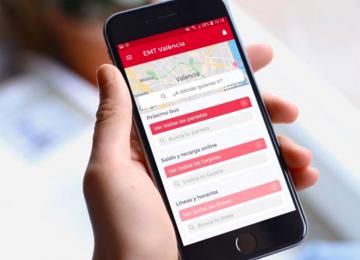
BUS AND UNDERGROUND ROUTE INFORMATION
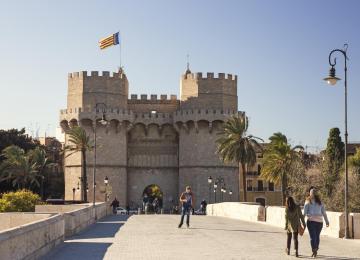
Historic Quarter

City of Arts and Sciences & Oceanogràfic
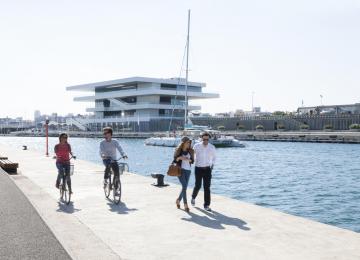
Poblados Marítimos District, Marina and Beaches

L’Albufera Natural Park
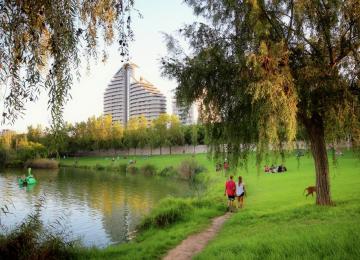
Bioparc and Cabecera Park
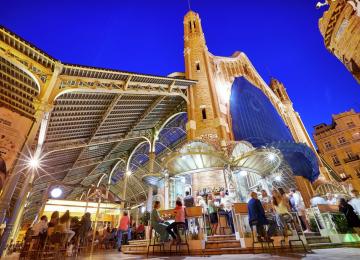
Ruzafa and Ensanche District
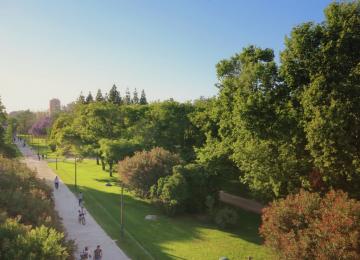
Turia Garden

Conference Centre
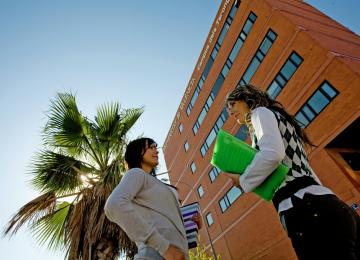
Universities
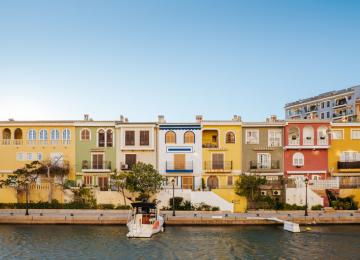
Port Saplaya
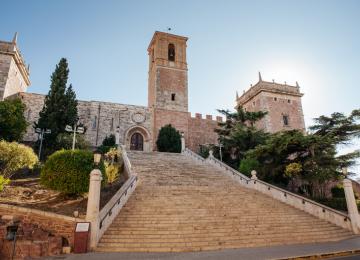
YOU MAY ALSO LIKE

Tour Valencia and its surroundings with the Valencia Tourist Card

Free tapa and beer with the Valencia Tourist Card
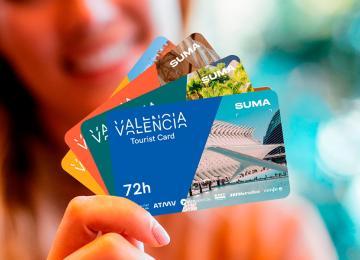
Valencia Tourist Card 24, 48 or 72 hours
Subscribe to our newsletter.
Do not miss the best plans in Valencia!
© VISIT VALÈNCIA 2024 | FUNDACIÓ VISIT VALÈNCIA
Accessibility notices
Timetables and planner
Maps and plans
- Travel rules
- Intermodality
- Service updates
- Customer service
- Complaints, claims, suggestions and acknowledgments
- Lost and Found
- Service charter
- Customer involvement committee
- Our tickets and passes
- Recharge your travel card
- Custom card
- Free Temporal Jove season ticket
- Our facilities
- NaviLens guidance and information system
- The metro is yours
- Metroescola
- A la Lluna de Metrovalencia
- Work for FGV
- Commercial services
- Environmental management and quality
- Contractor’s profile
Frequently asked questions
- Contractor's profile

- Timetables & Journeys
Route timetables
Station timetables
Plan your route
Favourite stations
You have not saved any stations yet
Your routes
You have not saved any routes yet
Start your trip
Start your next route, moving with you.

- Regulations
- Service Updates
- Advertising
- Shops at Metrovalencia
- Film shooting: The metro as a set
- Where we are
- Legal Warning
- Personal data protection
- Cookies policy
Copyright © Ferrocarrils de la Generalitat Valenciana 2021

- FGV Data protection
- Own / Strictly necessary cookies
- Third party cookies
- Other external technologies and services
- FGV Cookies policy
Basic information on personal data protection
The interested parties are provided with basic information on the processing of personal data carried out by Ferrocarrils de la Generalitat Valenciana entity, for the exercise of their authority; all in compliance with Articles 13 and 14 of Regulation (EU) 2016/679 of the European Parliament and of the Council of 27 April 2016 on the protection of natural persons with regard to the processing of personal data and on the free movement of such data, and repealing Directive 95/46/EC (hereinafter GDPR) as well as Organic Law 3/2018, of 5 December, on the Protection of Personal Data and guarantee of digital rights.
Person or entity responsible for the processing
In accordance with the provisions of Article 4.7 of the GDPR, "the natural or legal person, public authority, agency or other body which, alone or jointly with others, determines the purposes and means of the processing of personal data" shall be considered the Data Controller; in this case, FERROCARRILS DE LA GENERALITAT VALENCIANA (hereinafter, FGV) shall be considered the data controller.
E-mail: [email protected] Partida de Xirivelleta, s/n, 46014 - Valencia or Avenida de la Vilajoyosa, 2, Estación de la Marina, 03016 - Alicante.
Recording of Processing Activities
In accordance with the provisions of Article 30 of the GDPR, the updated list of the processing activities that FGV carries out is available in the Register of Processing Activities (Registro de Actividades), hereinafter RAT, published on the website of www.fgv.es/Portal de transparencia section Citizen Relations.
Collection of personal data
The personal data collected directly or indirectly from the interested party will be processed confidentially and will be incorporated into one of the processing activities owned by FGV that appear in its RAT.
When the personal data referring to the data subject is obtained from the data subject themselves, at the time of collection, the data subject shall be provided with the processing information, in a clear and intelligible form. If appropriate, the essential information about the processing will be provided on the collection form and a second layer of more detailed information will be indicated or linked from the collection form.
Uses and purposes
The processing of personal data will be in accordance with FGV's own functions and its use will be limited to those purposes for which it has been expressly collected.
If the personal data is intended to be further processed for a purpose other than that for which it was collected, the data subject will be informed prior to the further processing about this other purpose and will be provided with any additional relevant information, provided that the data subject does not already have this information.
The purpose of the processing of personal data will be that necessary for the administrative management and processing of the administrative procedures for which your data are requested, which will correspond to each of the processing activities carried out by FGV and which are accessible in the RAT .
No automated decisions will be made based on the processing of your personal data.
Processing legitimacy
In general, the legal basis for the processing of personal data by FGV is the fulfilment of legal obligations or the performance of actions in the public interest or in the exercise of public powers vested in the Generalitat Valenciana, in accordance with the rules governing the actions of public administrations and, in particular, Law 39/2015 of 1 October on the Common Administrative Procedure of Public Administrations and Law 40/2015 of 1 October on the Legal Regime of the Public Sector, the Statute of Autonomy and the Law of Government.
However, some processing may require the consent of the persons affected by the processing. In the cases in which the legal basis for the processing is the consent of the person concerned, FGV will put in place mechanisms that allow the consent to be granted by a clear affirmative action from this person and in such a way that evidence of it can be preserved.
The legal basis that enables each of the processing activities carried out by FGV can be consulted in the RAT.
According to the provision established in Article 14, paragraph 5.c) of the GDPR, the data from the processing that are the responsibility of the administration of the Consell or its instrumental public sector may be processed by bodies that have a supervisory, inspection or control function related to the exercise of public authority, provided that this access to data is expressly provided for in the regulations that regulate them (General Intervention, Inspection of Services, Delegation of Data Protection).
Data Retention
In general and without prejudice to the specific information published in the RAT , the personal data processed by FGV will be kept for the time necessary to fulfil the purpose for which they are collected.
Once the data has been removed or deleted from the processing, FGV may keep it in order to make it feasible to determine the possible liabilities that may arise from its processing or to allow its subsequent use, after the adoption of the appropriate protection measures, for historical, statistical or scientific purposes.
Data communication
The data controller will not communicate or publish personal data without the consent of the persons concerned, except in those circumstances provided for by the legislation in force. The intended recipients of data transfers for each of the processing activities can be consulted in the RAT
In addition to the above, it may be necessary to communicate data or allow access to them. This includes, in certain circumstances, the Ombudsman, the Síndic de Greuges, Judges and Courts, the Court of Auditors, Sindicatura de Comptes, the State Security Forces and Corps, in short, recipients to whom it is compulsory to communicate data at the request of investigation, infringement, supervision or control procedures. The Data Protection Officer of the Generalitat FGV will not use the data for commercial, advertising or any other purposes unrelated to its public authority, under any circumstances.
The rights of interested parties
The data subject may at any time exercise the rights guaranteed to data subjects by the GDPR under Articles 15 to 23, which are as follows:
RIGHT OF ACCESS : The interested party has the right to obtain confirmation from FGV of whether personal data concerning them are being processed, and if so, has the right to access this data and information regarding the purposes, recipients, categories of data processed, their origin and conservation period, claims, existence of automated decisions and their consequences, and all additional rights of rectification, deletion, limitation, opposition and portability.
RIGHT TO RECTIFICATION AND ERASURE : The interested party has the right to obtain the rectification of inaccurate or incomplete personal data concerning them from FGV, without undue delay. Likewise, the interested party has the right to request the deletion of personal data concerning them. If there is no other legal basis for its conservation, FGV will proceed to the deletion of the data when they are no longer necessary or have been processed unlawfully, when the data subject withdraws their consent in processing that requires it, or when they oppose to the processing.
RIGHT OF LIMITATION : The data subject has the right to obtain the limitation of data processing from FGV, in cases of contestation of the accuracy of the data, when the processing is unlawful and the data subject opposes the deletion of the personal data and requests instead the limitation of its use, when the data subject needs to keep the data in order to formulate or exercise claims or while verifying whether the legitimate reasons of the administration prevail over those of the data subject in case the data subject opposes the processing.
RIGHT OF OPPOSITION : The data subject has the right to object to the processing of personal data concerning them. FGV will cease to process these personal data, unless it can demonstrate compelling legitimate grounds for the processing that override the interests, rights and freedoms of the data subject, or for the formulation, exercise or defence of claims.
RIGHT OF PORTABILITY : The data subject has the right to receive their personal data in a structured, commonly used, machine-readable and interoperable format and to transmit it to another data controller, provided that the processing is legitimised on the basis of consent or within the framework of the performance of a contract and the processing is carried out by mechanised means. They also have the right, where technically feasible, to have the data transmitted directly from data controller to data controller. It shall not apply where the processing is necessary for the performance of a task carried out in the public interest in the exercise of public authority vested in the controller.
All of the above rights, including the withdrawal of consent, are of a highly personal nature and can therefore only be exercised by the person concerned. However, they may act through a representative in the cases and under the conditions provided for by the legislation in force.
Exercise of data protection rights of data subjects
The data subject may exercise their rights of access, rectification, deletion, limitation, portability and opposition by submitting a request accompanied by their National Identity Card or equivalent, through FGV's General Entry Register at Partida de Xirivelleta s/n, 46014 - Valencia or Avenida de la Villajoyosa, 2, Estación de la Marina, 03016 – Alicante, A/A Servicio de Protección de Datos Personales or through the Electronic Office of the Generalitat Valenciana.
If you consider that you have been harmed by the treatment that has been made of your personal data, in the attention of the exercise of your rights or have detected any breach of current regulations on data protection by FGV as Data Controller, you can file a complaint with the Data Protection Delegate of the Generalitat, either through a general request for electronic processing:
https://sede.gva.es/es/inicio/procedimientos?id_proc=22094 ,
or in person at any of the Public Registry Offices in accordance with the provisions of Law 39/2015, of October 1, of the Common Administrative Procedure of Public Administrations. All of the foregoing is without prejudice to the right to file a complaint with the Spanish Data Protection Agency through the mechanisms they offer published on their website: www.aepd.es .
More information regarding the processing of personal data in FGV in the Personal Data Protection section or in the Transparency Portal, Citizen Relations of www.fgv.es or through the e-mail address: [email protected] .
Strictly Necessary Cookie should be enabled at all times so that we can save your preferences for cookie settings.
If you disable this cookie, we will not be able to save your preferences. This means that every time you visit this website you will need to enable or disable cookies again.
This website uses Google Analytics to collect anonymous information such as the number of visitors to the site, and the most popular pages.
Keeping this cookie enabled helps us to improve our website.
Please enable Strictly Necessary Cookies first so that we can save your preferences!
Metrovalencia uses other external technologies and services that use persistent and technical cookies. As these providers will collect personal data such as your IP address, we allow you to block them in this section. The changes will take effect once you reload the page.
- Google Webfont services.
- Google Map services.
- Google reCaptcha services.
- Vimeo and Youtube video embeds.
You can consult our cookies policy

IMAGES
VIDEO
COMMENTS
04:00 - 23:00. Saturday - Sunday. 05:00 - 00:30. (these may be subject to change, so if you need exact times it is best to refer to the official Valencia Metro website - see link above). Valencia's metro system can prove handy for making your way around the city. The first step is to decide on a ticket that is most suited to the type of holiday ...
There are two metro lines that connect the airport to the city: Line 5 Airport/Torrent Avinguda- Neptú and Line 3 Airport / Palmaret- Rafelbunyol (Metrovalencia). About every 15-20 minutes. The ticket costs €4.80 (plus €1 for the card). This trip is free with the Valencia Tourist Card. Approximate duration: 20 minutes.
The cost of a 3-day metro ticket in Valencia depends on the number of zones you want to travel in. For example, if you're only planning on staying within Zone A, which covers the city center and immediate surroundings, the cost is €7.20. If you want to travel to zones B and C as well, the cost increases to €13.50.
The Valencia Tourist Card offers unlimited metro, bus, and tram travel for 24, 48, or 72 hours. It's a great option for tourists since it also includes free entry to city museums and discounts at restaurants. You can purchase the card online or at tourist info points across the city, including the airport.
There are 10 lines - 6 metro lines (lines 1, 2, 3, 5, 7, 9) and 4 tram lines (lines 4, 6, 8, 10). Trams and metros in Valencia are a clean, fast, reliable, and inexpensive way of moving around the city. All coaches are air-conditioned. Service frequency is 10 minutes on average but it varies greatly between individual lines and the time of ...
Valencia Metro Map: Map of the Underground System in Valencia, Spain. Valencia's metro system has six lines and covers most of the city. It is worth having a look at the metro map prior to your visit and checking out the closest metro to your accommodation. You can then check how to get to the various attractions that you would like to visit on ...
I find these are the most important lines to know as a tourist: Line 3: Connects the airport, the city center, and Benimaclet. Line 5: Connects the airport, the city center, and the beach. Line 7: Connects the city center and the beach. Line 10: Connects Russafa and the City of Arts and Sciences.
Metro Zones in Valencia. The Valencia metro system has Zone A, Zone B, and Zone C. The further you travel from the city center, the more expensive your ticket will be. For example, a single trip from Zone A to Zone B costs €1.50, but a trip from Zone B to Zone C costs €2.00. If you are not going to or from the airport, forget about Zone C.
Valencia Tourist Card. If you're a tourist planning to explore Valencia, the Valencia Tourist Card is a great option. It offers unlimited travel on buses, metro, and trams within Zone A, as well as discounts on entry tickets to many of Valencia's main attractions. The card is available for 24, 48, or 72 hours, and prices start at €15.
The Valencia Metro facilitates travel to prominent transportation hubs, including Valencia's primary train station (Estacio Nord), the central bus station (Estacion De Autobuses de Valencia), the cruise port (The Port of Palma's Poniente Quay), and Valencia Manises Airport (Aeropuerto de Manises), which boasts a dedicated metro line ...
Bus: price, timetables and frequency . If you have not purchased a Valencia Tourist Card, you have to pay for the ticket.You can buy a single ticket (1.5 euros) when boarding the bus or through the EMTicket app, a bus pass for €10.50 (€8.50 + €2 for the card), or the SUMA card for 10 trips on urban and intercity buses, metro, tram and suburban trains for €10 (€8 + €2 for the card).
Transport Passes. If you're only visiting for a few days and plan to use the metro infrequently, opt for a Bono metro Valencia ticket, which will give you 10 journeys in Zone A for €7.60 ($8.80). If you're going to be traveling around Valencia quite a bit and on various modes of transport, get an integrated Valencia public-transport ticket.
Line 1: (Bétera - Villanueva Castellón) covers almost 100 km and is the longest. Line 2: (Llíria - Torrent Avinguda) has stops at strategic points such as the Turia Gardens and Plaza de España. Line 3: (Rafelbunyol - Aeroport) the most used and connects directly to the airport. Line 4: (Mas del Rosaries - Dr. Lluch) is a tram line.
The metro in Valencia is operated by Metrovalencia. As you can see on the map of Metrovalencia below, the metro (or subway) is useful to get to the outer edges of the city quickly, but doesn't serve as many stops as the bus. A single Valencia metro ticket will cost you €1.50 (~ $1.70) within one zone. Zone A is the biggest zone, enclosing ...
VALENCIA TOURIST CARD. With the Valencia Tourist Card, you get FREE admission to municipal museums and monuments and special discounts on Valencia's main tourist attractions. In addition, with the 24-, 48- or 72-hour Valencia Tourist Card, you can travel FOR FREE on urban and metropolitan buses, metro, tram and commuter trains.
Public transport discounts - 1st September to 31st December 2022. The Valencian government has introduced a discount on multi-journey transport passes. The discount brings the price of a SUMA 10 pass (valid for metro, tram, buses, and railways) down to €5.60 (one zone), €8.40 (two zones), and €14.00 (three zones). Single tickets remain ...
The maximum travel time between metro and tram lines is 90 minutes for journeys on zonal combinations consisting of 1 zone and 150 minutes for journeys on all other zonal combinations, counted from the validation of the ticket. ... 46014 - Valencia or Avenida de la Vilajoyosa, 2, Estación de la Marina, 03016 - Alicante.
This way your new metro ride (s) will be loaded on the existing ticket. You save € 1.00 and waste less paper. Tip: if you are staying in Valencia longer you can ask the ticket office for a more durable plastic card. The card costs € 2.00 and cannot be obtained at a ticket machine.
It operates every day from around 5.30am to 23.00pm. Metro tickets are reasonably priced, starting from €1.50, and further savings can be made by purchasing a Bonometro. The maximum time allowed on the metro is between 90 and 150 minutes, depending on the number of zones you travel through.
The data subject may exercise their rights of access, rectification, deletion, limitation, portability and opposition by submitting a request accompanied by their National Identity Card or equivalent, through FGV's General Entry Register at Partida de Xirivelleta s/n, 46014 - Valencia or Avenida de la Villajoyosa, 2, Estación de la Marina ...
FREE urban transport: Travel for free on city buses (EMT) and metropolitan buses (Metrobus), underground (AB zones, including the airport stop), tram and commuter trains (Renfe) in zone AB. Free admission to municipal museums and monuments. Discounts of up to 50% on other museums and attractions, stores, restaurants and other tourist services.
Free public transport with the Valencia Tourist Card. With this card, you can travel for free on city (EMT) and metropolitan (Metrobus) buses, metro (AB zones, with airport stop included)) tram and commuter trains (Renfe) in zone AB. The city has 60 bus lines, 9 metro and tram lines and 6 commuter train lines to take you anywhere you want ...
The data subject may exercise their rights of access, rectification, deletion, limitation, portability and opposition by submitting a request accompanied by their National Identity Card or equivalent, through FGV's General Entry Register at Partida de Xirivelleta s/n, 46014 - Valencia or Avenida de la Villajoyosa, 2, Estación de la Marina ...